Home Blog Presentation Ideas How to Start a Presentation: 5 Strong Opening Slides and 12 Tricks To Test

How to Start a Presentation: 5 Strong Opening Slides and 12 Tricks To Test

Knowing how to start a presentation is crucial: if you fail to capture the audience’s attention right off the bat, your entire presentation will flop. Few listeners will stick with you to the end and retain what you have told.
That is mildly unpleasant when you are doing an in-house presentation in front of your colleagues. But it can become utterly embarrassing when you present in front of larger audiences (e.g., at a conference) or worse – delivering a sales presentation to prospective customers.
Here is how most of us begin a presentation: give an awkward greeting, thank everyone for coming, clear our throats, tap the mic, and humbly start to mumble about our subject. The problem with such an opening performance? It effectively kills and buries even the best messages.
Table of Contents
- The Classic Trick: Open a Presentation with an Introduction
- Open a Presentation with a Hook
- Begin with a Captivating Visual
- Ask a “What if…” Question
- Use the Word “Imagine”
- Leverage The Curiosity Gap
- The Power of Silence
- Facts as Weapons of Communication
- Fact vs. Myths
- The Power of Music
- Physical Activity
- Acknowledging a Person
How to Start a PowerPoint Presentation The Right Way
Let’s say you have all of your presentation slides polished up (in case you don’t, check our quick & effective PowerPoint presentation design tips first). Your presentation has a clear storyline and agenda. Main ideas are broken into bite-sized statements for your slides and complemented with visuals. All you have left is to figure out how you begin presenting.
The best way is to appeal to and invoke certain emotions in your audience – curiosity, surprise, fear, or good old amusements. Also, it is recommended to present your main idea in the first 30 seconds of the presentation. And here’s how it’s done.
1. The Classic Trick: Open a Presentation with an Introduction

When you don’t feel like reinventing the wheel, use a classic trick from the book – start with a quick personal introduction. Don’t want to sound as boring as everyone else with your humble “Hi, I’m John, the head of the Customer Support Department”? Great, because we are all about promoting effective presentation techniques (hint: using a dull welcome slide isn’t one of them).
Here’s how to introduce yourself in a presentation the right way.
a. Use a link-back memory formula
To ace a presentation, you need to connect with your audience. The best way to do so is by throwing in a simple story showing who you are, where you came from, and why your words matter.
The human brain loves a good story, and we are more inclined to listen and retain the information told this way. Besides, when we can relate to the narrator (or story hero), we create an emotional bond with them, and, again – become more receptive, and less skeptical of the information that is about to be delivered.
So here are your presentation introduction lines:
My name is Joanne, and I’m the Head of Marketing at company XYZ. Five years ago I was working as a waitress, earning $10/hour and collecting rejection letters from editors. About ten letters every week landed to my mailbox. You see, I love words, but decent publisher thought mine were good enough. Except for the restaurant owner. I was very good at up-selling and recommending dishes to the customers. My boss even bumped my salary to $15/hour as a token of appreciation for my skill. And this made me realize: I should ditch creative writing and focus on copywriting instead. After loads of trial and error back in the day, I learned how to write persuasive copy. I was no longer getting rejection letters. I was receiving thousands of emails saying that someone just bought another product from our company. My sales copy pages generated over $1,500,000 in revenue over last year. And I want to teach you how to do the same”
b. Test the Stereotype Formula
This one’s simple and effective as well. Introduce yourself by sharing an obvious stereotype about your profession. This cue will help you connect with your audience better, make them chuckle a bit, and set a lighter mood for the speech to follow.
Here’s how you can frame your intro:
“My name is ___, and I am a lead software engineer at our platform [Your Job Title]. And yes, I’m that nerdy type who never liked presenting in front of large groups of people. I would rather stay in my den and write code all day long. [Stereotype]. But hey, since I have mustered enough courage…let’s talk today about the new product features my team is about to release….”
After sharing a quick, self-deprecating line, you transition back to your topic, reinforcing the audience’s attention . Both of these formulas help you set the “mood” for your further presentation, so try using them interchangeably on different occasions.
2. Open a Presentation with a Hook
Wow your audience straight off the bat by sharing something they would not expect to hear. This may be one of the popular first-time presentation tips but don’t rush to discard it.
Because here’s the thing: psychologically , we are more inclined to pay attention whenever presented with an unexpected cue. When we know what will happen next – someone flips the switch, and lights turn on – we don’t really pay much attention to that action.
But when we don’t know what to expect next – e.g., someone flips the switch and a bell starts ringing – we are likely to pay more attention to what will happen next. The same goes for words: everyone loves stories with unpredictable twists. So begin your presentation with a PowerPoint introduction slide or a line that no one expects to hear.
Here are a few hook examples you can swipe:
a. Open with a provocative statement
It creates an instant jolt and makes the audience intrigued to hear what you are about to say next – pedal back, continue with the provocation, or do something else that they will not expect.
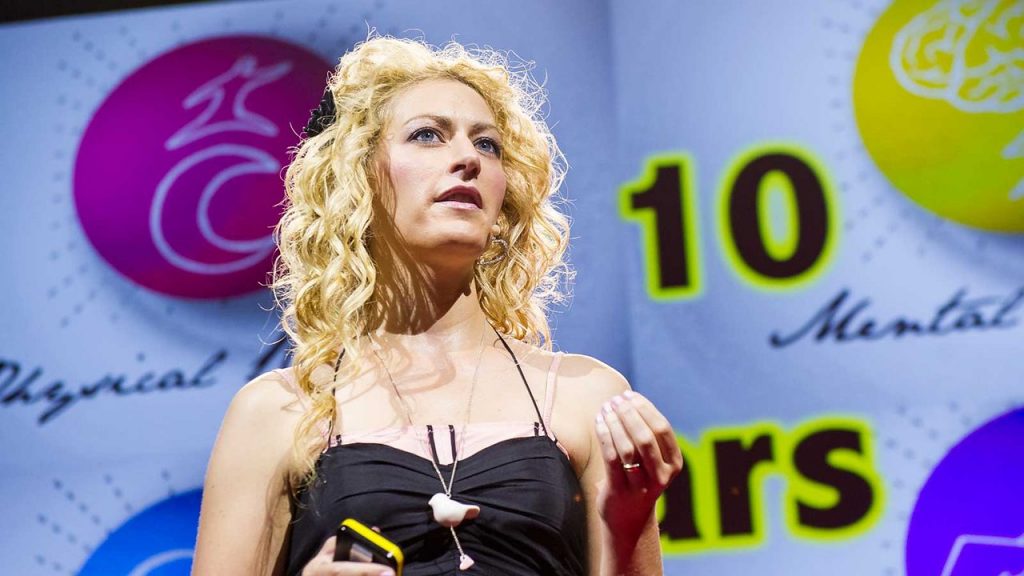
“You will live seven and a half minutes longer than you would have otherwise, just because you watched this talk.”
That’s how Jane McGonigal opens one of her TED talks . Shocking and intriguing, right?
b. Ask a rhetorical, thought-provoking question
Seasoned presenters know that one good practice is to ask a question at the beginning of a presentation to increase audience engagement. Rhetorical questions have a great persuasive effect – instead of answering aloud, your audience will silently start musing over it during your presentation. They aroused curiosity and motivated the audience to remain attentive, as they did want to learn your answer to this question.
To reinforce your message throughout the presentation, you can further use the Rhetorical Triangle Concept – a rhetorical approach to building a persuasive argument based on Aristotle’s teachings.
c. Use a bold number, factor stat
A clean slide with some mind-boggling stat makes an undeniably strong impact. Here are a few opening statement examples you can use along with your slide:
- Shock them: “We are effectively wasting over $1.2 billion per year on producing clothes no one will ever purchase”
- Create empathy: “Are you among the 20% of people with undiagnosed ADHD?”
- Call to arms: “58% of marketing budgets are wasted due to poor landing page design. Let’s change this!”
- Spark curiosity: “Did you know that companies who invested in speech recognition have seen a 13% increase in ROI within just 3 years?”
3. Begin with a Captivating Visual
Compelling visuals are the ABC of presentation design – use them strategically to make an interesting statement at the beginning and throughout your presentation. Your first presentation slide can be text-free. Communicate your idea with a visual instead – a photo, a chart, an infographic, or another graphics asset.
Visuals are a powerful medium for communication as our brain needs just 13 milliseconds to render what our eyes see, whereas text comprehension requires more cognitive effort.
Relevant images add additional aesthetic appeal to your deck, bolster the audience’s imagination, and make your key message instantly more memorable.
Here’s an intro slide example. You want to make a strong presentation introduction to global pollution. Use the following slide to reinforce the statement you share:

“Seven of nine snow samples taken on land in Antarctica found chemicals known as PFAs, which are used in industrial products and can harm wildlife”
Source: Reuters
4. Ask a “What if…” Question
The “what if” combo carries massive power. It gives your audience a sense of what will happen if they choose to listen to you and follow your advice. Here are a few presentations with starting sentences + slides to illustrate this option:
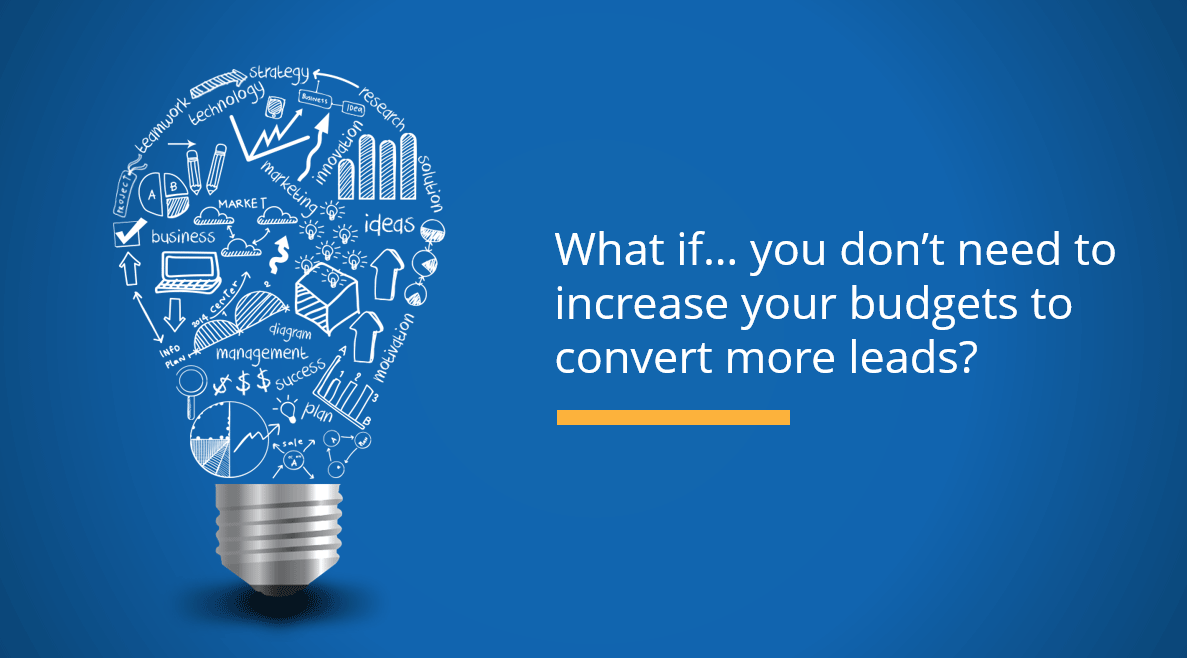
Alternatively, you can work your way to this point using different questions:
- Ask the audience about their “Why.” Why are they attending this event, or why do they find this topic relevant?
- Use “How” as your question hook if you plan to introduce a potential solution to a problem.
- If your presentation has a persuasion factor associated, use “When” as a question to trigger the interest of the audience on, for example, when they are planning to take action regarding the topic being presented (if we talk about an inspirational presentation).

5. Use the Word “Imagine”
“Imagine,” “Picture This,” and “Think of” are better word choices for when you plan to begin your presentation with a quick story.
Our brain loves interacting with stories. In fact, a captivating story makes us more collaborative. Scientists have discovered that stories with tension during narrative make us:
- Pay more attention,
- Share emotions with the characters and even mimic the feelings and behaviors of those characters afterward.
That’s why good action movies often feel empowering and make us want to change the world too. By incorporating a good, persuasive story with a relatable hero, you can also create that “bond” with your audience and make them more perceptive to your pitch – donate money to support the cause; explore the solution you are offering, and so on.
6. Leverage The Curiosity Gap
The curiosity gap is another psychological trick frequently used by marketers to solicit more clicks, reads, and other interactions from the audience. In essence, it’s the trick you see behind all those clickbait, Buzzfeed-style headlines:

Not everyone is a fan of such titles. But the truth is – they do the trick and instantly capture attention. The curiosity gap sparks our desire to dig deeper into the matter. We are explicitly told that we don’t know something important, and now we crave to change that. Curiosity is an incredibly strong driving force for action – think Eve, think Pandora’s Box.
So consider incorporating these attention grabbers for your presentation speech to shock the audience. You can open with one, or strategically weave them in the middle of your presentation when you feel like your audience is getting tired and may lose their focus.
Here’s how you can use the curiosity gap during your presentation:
- Start telling a story, pause in the middle, and delay the conclusion of it.
- Withhold the key information (e.g., the best solution to the problem you have described) for a bit – but not for too long, as this can reduce the initial curiosity.
- Introduce an idea or concept and link it with an unexpected outcome or subject – this is the best opening for a presentation tip.
7. The Power of Silence
What would you do if you attended a presentation in which the speaker remains silent for 30 seconds after the presentation starts? Just the presenter, standing in front of the audience, in absolute silence.
Most likely, your mind starts racing with thoughts, expecting something of vital importance to be disclosed. The surprise factor with this effect is for us to acknowledge things we tend to take for granted.
It is a powerful resource to introduce a product or to start an inspirational presentation if followed by a fact.
8. Facts as Weapons of Communication
In some niches, using statistics as the icebreaker is the best method to retain the audience’s interest.
Say your presentation is about climate change. Why not introduce a not-so-common fact, such as the amount of wool that can be produced out of oceanic plastic waste per month? And since you have to base your introduction on facts, research manufacturers that work with Oceanic fabrics from recycled plastic bottles .
Using facts helps to build a better narrative, and also gives leverage to your presentation as you are speaking not just from emotional elements but from actually recorded data backed up by research.
9. Fact vs. Myths
Related to our previous point, we make quite an interesting speech if we contrast a fact vs. a myth in a non-conventional way: using a myth to question a well-accepted fact, then introducing a new point of view or theory, backed on sufficient research, that proves the fact wrong. This technique, when used in niches related to academia, can significantly increase the audience’s interest, and it will highlight your presentation as innovative.
Another approach is to debunk a myth using a fact. This contrast immediately piques interest because it promises to overturn commonly held beliefs, and people naturally find it compelling when their existing knowledge is put to the test. An example of this is when a nutritionist wishes to speak about how to lose weight via diet, and debunks the myth that all carbohydrates are “bad”.
10. The Power of Music
Think about a presentation that discusses the benefits of using alternative therapies to treat anxiety, reducing the need to rely on benzodiazepines. Rather than going technical and introducing facts, the presenter can play a soothing tune and invite the audience to follow an exercise that teaches how to practice breathing meditation . Perhaps, in less than 2 minutes, the presenter can accomplish the goal of exposing the advantages of this practice with a live case study fueled by the proper ambiance (due to the music played in the beginning).
11. Physical Activity
Let’s picture ourselves in an in-company presentation about workspace wellness. For this company, the sedentary lifestyle their employees engage in is a worrying factor, so they brought a personal trainer to coach the employees on a basic flexibility routine they can practice in 5 minutes after a couple of hours of desk time.
“Before we dive in, let’s all stand up for a moment.” This simple instruction breaks the ice and creates a moment of shared experience among the attendees. You could then lead them through a brief stretching routine, saying something like, “Let’s reach up high, and stretch out those muscles that get so tight sitting at our desks all day.” With this action, you’re not just talking about workplace wellness, you’re giving them a direct, personal experience of it.
This approach has several advantages. Firstly, it infuses energy into the room and increases the oxygen flow to the brain, potentially boosting the audience’s concentration and retention. Secondly, it sets a precedent that your presentation is not going to be a standard lecture, but rather an interactive experience. This can raise the level of anticipation for what’s to come, and make the presentation a topic for future conversation between coworkers.
12. Acknowledging a Person
How many times have you heard the phrase: “Before we begin, I’d like to dedicate a few words to …” . The speaker could be referring to a mentor figure, a prominent person in the local community, or a group of people who performed charity work or obtained a prize for their hard work and dedication. Whichever is the reason behind this, acknowledgment is a powerful force to use as a method of starting a presentation. It builds a connection with the audience, it speaks about your values and who you admire, and it can transmit what the conversation is going to be about based on who the acknowledged person is.
Closing Thoughts
Now you know how to start your presentation – you have the opening lines, you have the slides to use, and you can browse even more attractive PowerPoint presentation slides and templates on our website. Also, we recommend you visit our article on how to make a PowerPoint Presentation to get familiarized with the best tactics for professional presentation design and delivery, or if you need to save time preparing your presentation, we highly recommend you check our AI Presentation Maker to pair these concepts with cutting-edge slide design powered by AI.
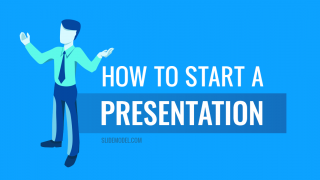
Like this article? Please share
Curiosity Gap, Opening, Public Speaking, Rhetorical Triangle, Speech, What If Filed under Presentation Ideas
Related Articles

Filed under Presentation Ideas • September 5th, 2023
Persuasive Speech: Actionable Writing Tips and Sample Topics
Business professionals, students, and others can all benefit from learning the principles of persuasive speech. After all, the art of persuasion can be applied to any area of life where getting people to agree with you is important. In this article, we get into the basics of persuasive speaking, persuasive speech writing, and lastly persuasive speech topics.
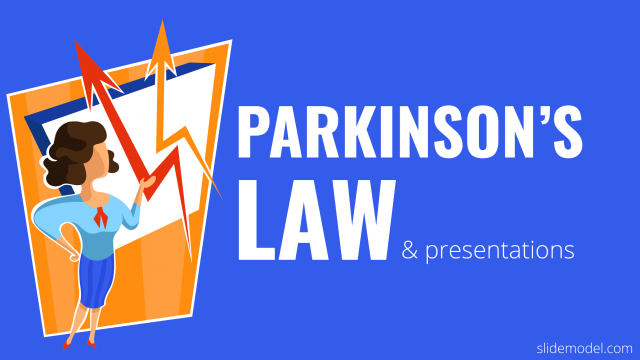
Filed under Presentation Ideas • August 5th, 2023
How Parkinson’s Law Can Make Your Presentations Better
Sometimes even the best presenters procrastinate their work until the very last moment. And then, suddenly, they get a flow of ideas to complete their slide deck and present like they have been preparing for it for ages. However, doing so has drawbacks, as even professional presenters cannot always elude the side effects of […]
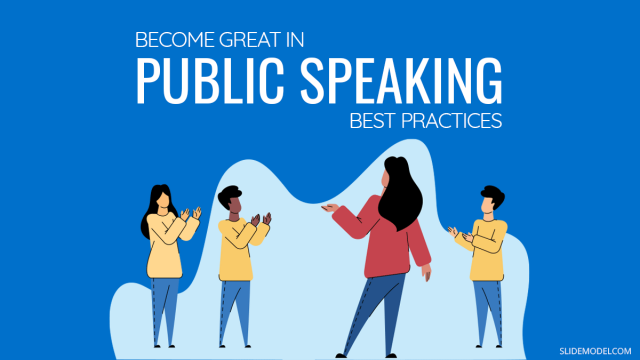
Filed under Presentation Ideas • April 29th, 2022
How to Become Great in Public Speaking: Presenting Best Practices
Public Speaking takes a lot of practice and grit, however, it also requires a method that can help you through your presentation. Explore more about this subject in this blog post.
5 Responses to “How to Start a Presentation: 5 Strong Opening Slides and 12 Tricks To Test”
I love to follow the ideas, it’s good for a freshman
Leave a Reply
- Scroll to top

The 10 best presentation openers.
First impressions count. Adopt these techniques to keep your audience rapt from the get-go. Here are the ten best presentation openers.
Some say it’s 15 seconds; others 30. A few generous souls will even allot up to 60 seconds. Whatever the case, this much is indisputable: you’ve got one minute max in which to capture your audience’s attention at the start of your presentation. After that, they’re gone.
Physically they’re still occupying the same space, give or take a fidget, but mentally they’re reliving last night’s Netflix marathon, or pondering whether centaurs really have two rib cages. Miss that window of opportunity – those precious seconds in which all eyes really are on you – and you’ve lost your audience.
The beginning of the story
Way before you fire up PowerPoint, you’re crafting your narrative and what better way to start than at the beginning? We like you, you’re smart.
Every presentation is a story. Or at least it should be. It needs to have a clear beginning, middle, and end. As this article is about the best presentation openers, we’ll focus on the beginning. To start your presentation off correctly, you need to be connecting with your audience by setting the scene. Make it clear you understand their industry, the current climate, and give them a sneak peek of what’s coming.
But how do you connect with your audience in the beginning? Well, it depends on the story that you’re telling, but this article is going to take you through the ten best presentation openers according to Hype Presentations.
10 best presentation openers to start a presentation
1. the statistic .
You don’t want to be splurging all your most important data on your audience at the start – you’ll want to build a crescendo of messaging towards the big reveal later. But a surprising or impressive statistic to start your presentation can help to hook your audience’s attention.
To avoid confused stares, it’s important you seat any statistic in the proper context. Don’t just deliver the number on its own, frame it in a way that demonstrates why it matters to them.
For example, try something like ‘By the time I’ve finished this talk, X people will have been affected by [subject]’ as opposed to ‘[Subject] affects X people annually’.
2. The questi o n
Ah, starting off with a question: an oldie but goodie from the dusty depths of the public speaking toolkit. And there’s a reason it’s been around so long: it works. By addressing your audience directly, you increase engagement.
There are a few ways you can go about opening your presentation with a question. You can use an entirely rhetorical one, to get your audience thinking about and reflecting on your topic. Or you can seek responses to turn your presentation into a two-way conversation.
Starting a presentation with a question helps establish an element of interactivity, and while people might not want to be the first to speak out, you can pick individual audience members and ask them to elaborate after they’ve put their hands up. It’s less of a scary schoolteacher vibe.
3. The opinion
If you want to stand out with your presentation opener, be the black sheep in the flock. There’s currency in being a contrarian, and it’s about more than just shock value. Do you remember the film Dead Poet’s Society, where Robin Williams urges his students to rip out the opening page of their textbooks? That’s what you’ve got to do.
‘As you all know, muscle growth is about progressive overload, clean eating, and smart supplementation.’
‘Well, I’m here to tell you that’s a big fat lie. Forget everything you’ve heard about strength training. If you wanna get swole, here’s what you should do…’
Your audience might not agree with you, but one thing they certainly can’t do is ignore you. Don’t be a contrarian for the sake of it, of course, but if you genuinely have an unconventional approach, don’t be afraid to put it out there from the start.
4. The Value Proposition
Another good way to start your presentation is to jump straight to addressing the audience’s selfish motives. They only care about their own needs and priorities, and the whole reason that they showed up to listen to you is because they want to derive value from your presentation.
You can get them listening closely by acknowledging this fact and letting them know exactly what they’ll get out of it, if they just pay attention for a little longer. Try something like ‘By the end of this talk, you’ll know how to generate more sales through inbound marketing’. Obviously, don’t promise anything that you can’t deliver, as this risks damaging your credibility.
5. The problem solver
For your presentation to be successful, you need to show how you can solve a problem for your audience. So, why not open by describing it?
Really dig into the pain points that the problem causes – amplify how bad the current situation is and why it needs to be solved. Once your audience recognises the breadth and depth of the problem, you’re in a prime position to solve it with the rest of your presentation.
6. The reference
Refer to something your audience will know about, and that is relevant to them. It might be a flashpoint in their industry, or something of wider cultural significance. This provides the opportunity to establish context and set out your points, connecting them to a bigger picture from the start of the presentation, as well as showing you understand their world.
7. The quote
We live in a world of aphorisms, maxims, and Pinterest-shared platitudes. If you’re planning your presentation opener to be a quote, better make it a banger. It doesn’t have to be famous – it just has to be memorable. Your audience has probably received a lifetime supply of canned MLK quotes and can recite Steve Jobs’ Stanford commencement address off by heart. If you’re planning to start with a cliche-free quote, you’re going to need to, um, think outside the box. Ahem.
‘A good speech is like a pencil; it has to have a point.’
That’s good. Thanks Pinterest. To get your audience interacting with you from the outset, put a quote on your first slide and ask them who it’s from. Or reveal the first half of the quote and get them to guess how it ends. Instantly, they’re involved and have gone from being a passive to an active audience.
8. The j o ke
Be wary. A high-pressure sales environment might not be the best place to make jokes. Neither would a report to investors , detailing how you’ve lost all their money. However, in the right situation, starting your presentation with some humour could help you appear more relaxed, confident, relatable, and creative.
If you do start your presentation with a joke, please don’t wait expectantly for the laugh. They might laugh, they might not. Either way, quickly move on and keep the presentation going.
9. The secret
‘Hi. My name is Mark and, at weekends, I like to wear my girlfriend’s lingerie.’
No, not that sort of secret.
‘Hi. My name is Mark and I’d like to share a secret with you. When I started this job, my greatest fear was public speaking.’
Better. Now you’ve revealed a vulnerability, and your audience can empathise with you. If they possess even a sliver of humanity, they should be willing you on after such an admission.
‘Then I learned to conquer my fear of public speaking. Now, the only things that scare me are the Tarantula Wolf Spider and 4% battery.’
We’ve left confessional territory behind now and delved into humour. But, in truth, you can steer your presentation any which way you like from this point. You’ve already piqued your audience’s curiosity. Now you have their attention.
10. The picture
Humans are hardwired to remember faces over names. Memory isn’t a spreadsheet – it’s a rich visual tapestry. Start your presentation with a strong image and it’ll do the hard work for you.
A powerful image will evoke equally powerful emotions: awe; surprise; disgust. Okay, so you probably want to avoid grossing out your audience, but don’t be afraid to make them feel. Whether it’s a cute puppy dog or an iconic war photograph, a powerful picture will sear itself into their consciousness better than a dozen text-heavy slides ever could.
The storytelling loop
Forget about your interests and life experience, it’s all about your audience. How can you tailor your presentation opener to appeal to your audience? Think about their industry and interests. A room of coders will respond better to a joke about Linux than a room of event planners. A group of art students will find a Picasso anecdote more relatable than one about Socrates.
Once you’ve settled upon one of these presentation openers, it’s a good idea to return to it when closing your presentation. This completes the storytelling loop and leaves your take-home message fixed firmly in mind. Conclude that confession. Finish that quote. Captivate that crowd.
However you start your presentation, make it memorable. Make it explosive. Make it count. After that, the hard work’s done: you’ve got your audience’s attention and they’re keen to hear what else you’ve got to say.
Recent Posts

- Posted by hypepresentations
How many slides should I have in my PowerPoint presentation?
When you’re planning out your next big presentation, it can be hard...
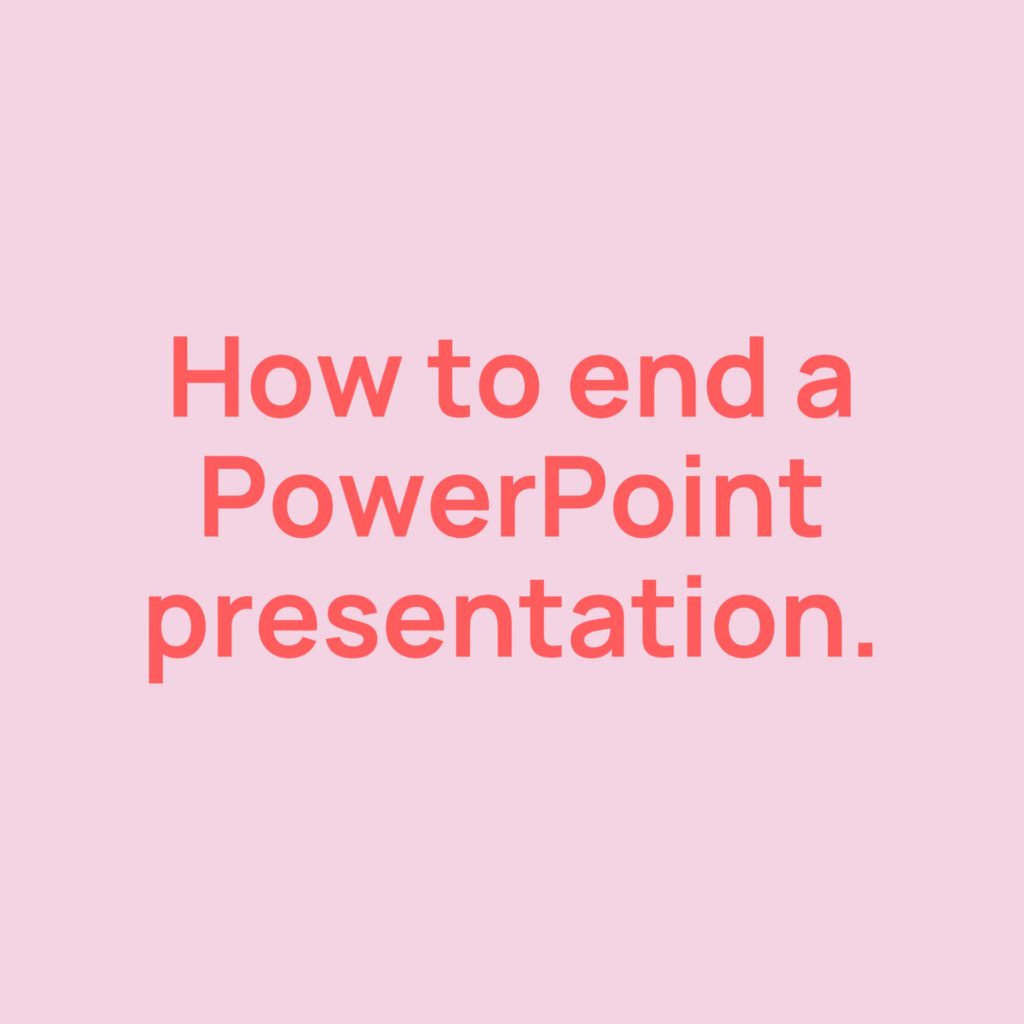
How to end a PowerPoint presentation.
By the time you reach the end of your PowerPoint presentation, it’s...

9 Killer Speech Openers to Start a Talk or Presentation.

Danny Riley 8 min read
What you’ll learn:
- The importance of a “killer” speech opening.
- 9 powerful speech openers and how to use them.
- Examples from great speakers you can learn from.

Great speech openers hook your audience.
“ Well begun is half done” – Mary Poppins.
A killer speech opener will make the difference between a presentation that makes you soar or your audience snore .
I’ve researched the whole web to find nine killer speech openers to make your audience lean in and listen rather than tune out and daydream.
You’ll see how masters of the craft have used them, and how you can too.
Number seven takes hutzpah to pull off. Ready for the whole list of killer speech openers?
The Shock Opener
One of the best ways to open your speech with a buzz is to startle or shock them.
You can shock an audience in many ways, but they all rest on the major senses of VAKS:
- Kinesthetic (touch)
We don’t want your audience tasting your talk, but it should leave a good taste in their mouths.
Changing Minds suggests asking if the audience is awake after appearing from a flashbang and a cloud of smoke, and this might work for you if you’re a magician or playing some kind of character for your speech like a genie.
Suppose you aren’t going for the magic angle.
In that case, you can shock them on a psychological level instead, as Conor Neill recommends, and tell your audience a surprising fact or statistic that makes them question their thinking or beliefs.
“Did you know that half the water on earth is older than the sun?”
Questions like these will shake an audience awake and turn on their critical thinking nervous-system.
Don’t take my word for it; you can see an incredible demonstration of the shock opener in Mohammed Qahtani’s speech, The Power of Words .
Qahtani opens by taking out a cigarette and placing it into his mouth before trying to light it. The audience is so shocked that they gasp and tell him to stop.
Remember, if your audience is shocked, they are listening.
Your audience doesn’t always have to be jolted to attention with a shock opener, though you can use a more subtle approach to grab their focus.
Ready to speak with confidence ? Explore our training options...
The story opener.
You can set the tone of your speech instantly with a story .
In Hollywood, filmmakers and directors use an ‘establishing shot’ to set the tone and theme of the entire film.
When creating your speech, think of a short story that sums up your talk.
Maybe you tell half the story to begin with, and then the other half at the end.
The important thing is your tale must be relatable . If your audience can’t imagine themselves in the story, they won’t be engaged.
We all experience very similar things in life:
- We all went to school and had a teacher we loved
- We all have parents who loved us or made mistakes in our upbringing
- We all had a first crush.
We are all cut from the same cloth, so it’s good to be reminded that others are going through what we face or think as we do.
Bryan Stevenson does a stellar job of recounting his mischievous grandmother in his TED talk, We need to talk about an injustice .
The best thing is, you can combine a story-opener with any other speech opener in this list.
It’s truly versatile.
One of my favourite speech openers is next, though.
The Intrigue Opener
I love this speech opener.
What better way to hook your audience than to intrigue them with mystery or a juicy secret?
Take a look at Daniel Pink’s TED Talk The puzzle of motivation . After he begins, Pink, looking like a guilty man sent to the gallows tells his audience:
“I need to confess something, at the outset here. A little over 20 years ago, I did something I regret. Something I’m not particularly proud of”.
Wow. How intriguing, right?
You have to admit; you want to know what he’s about to confess.
Choose every sentence, every word, and every mark of punctuation to increase the tantalisation temperature.
Whether it’s a secret or confession, the Intrigue Opener piques just enough curiosity in your audience to keep them from checking Whatsapp.
As humans, we need closure.
We do not like open loops.
That’s why it is both enthralling and aggravating when someone plays on our need to be sure.
Just as we cannot stand an open loop, we are instantly engaged when someone gives us a puzzle to solve.
You’ll notice the best speeches, books, tv shows, and films do not spoon feed you all of the information.
I’ve always liked the way Malcolm Gladwell writes his non-fiction books because they contain puzzles that you solve as a reader.
This puzzle needs to be related to the speech or presentation you’re delivering, of course. It cannot be a random puzzle and will ideally be impossible or extremely difficult to solve at first.
After the speech begins and the puzzle is revealed, you should slowly drop hints on how to solve the mystery.
Up next, speech openers that use a physical object to create curiosity in the audience’s mind.
The Prop Opener
One of the most potent ways you will captivate your audience is to use a powerful prop in your opening address.
What better way to capture an audience’s imagination than to show them a mysterious or beautiful object?
If you’ve never seen the Prop Opener done well, then take a look at one of the greatest speeches of all time:
Dananjaya Hettiarachchi’s, See Something .
Danajaya enters with a simple rose in his breast pocket, takes it out, gazes at it nostalgically, smells it and then begins to speak.
This same prop appears again right at the end of his speech to end his talk with a flourish.
There are many different props you can use.
JJ Abrams used a Mystery Box to absorb the audience’s attention and used the box as a metaphor for his entire career.
If you think the prop opener is just for TED Talks and Toastmasters Final Speeches, remember that most company product launch centre around one or more props.
Steve Jobs revealed his new products in ever-innovative ways.
Still, while the last two speeches I’ve mentioned opened with physical items, most of Jobs’s presentations built intrigue through the sight of the product.
So remember, you can use an object, or tease your audience with the absence of a prop, but make that prop integral to your talk.
You don’t always have to use a prop, of course.
A more minimalist approach to opening your speech uses the best audience reaction a speaker can receive: laughter.
The Funny Opener
Using laughter to win over your audience is the golden ticket to immediate rapport with your audience.
Jack Schafer, PhD at Psychology Today, said that People Will Like You If You Make Them Laugh , which seems obvious, but at least you know we have scientists on the case.
He also mentions that constructing humour requires and projects a high level of intelligence .
Of course, laughter is subjective, but it is also infectious, and if you get enough members of your audience to titter, it will spread across the whole group.
If you want to see just how quickly you can win an audience over with humour, take a look at Ken Robinson’s subtle but delightful ability to raise a chuckle in his speech Do Schools Kill Creativity?
Ken’s ability to speak conversationally to an audience of thousands is genuinely remarkable.
If you break down his humour, it is easy to see how you could include similar content in your presentations.
Whether you can pull it off as well as Ken is another story.
Not everyone feels like they can be a comedian, though; I get that.
Well, that’s alright because there are other ways to open your talk that play on other strong emotions.
You can inspire your audience too.
The Inspirational Opener
One of my favourite ways to help beginner speakers to open their presentation is with a quote.
A quote acts like a story in that it sets the tone and theme of your speech, but it takes much less effort and even less skill.
An effective quote is usually only one line long and supported by the credibility of the original author who uttered those words.
Watch the way Clint Smith opens his TED Talk The Danger of Silence .
Using Martin Luther King’s voice to start his speech gives Clint what psychologists call the transference effect .
Just by citing someone else, especially someone admired and famous, you redirect the emotions an audience have towards that person onto yourself.
One caveat to using quotes, though:
Fact check them . I cringe whenever I see someone incorrectly quoting someone.
Have you ever heard the quote by Albert Einstein:
“Insanity is doing the same thing over and over, and expecting different results”?
A great quote, isn’t it?
But Albert Einstein never said those words .
A quick check on Reuters will help you add more credibility to your inspirational opener.
Finally, try to use a quote few people have ever heard. Inspiring words have been filling the archives of history for millennia, so seek out something that has been left dusty on the shelf rather than the same recycled iterations.
Next, let’s look at a type of bold speech opener that take real hutzpah to land well.
The Perspective Shift Opener
A powerful speech opener that will take confidence is the perspective shift opener.
This opener will lead the audience in one direction before changing direction and setting a new pace for the speech.
Cameron Russel does a fantastic job of controlling the frame in her TED Talk Looks aren’t everything. Believe me; I’m a model.
Russel takes to the stage dressed in a skimpy dress and begins to tell the audience about her career, but then does a rapid wardrobe change on stage in front of the entire audience.
This change of dress sets a new tone, feel, and direction for the speech.
If you can change the audience’s perspective or frame of reality, you are in the driving seat.
One of the best things you can hope for as a speaker is moving hearts and changing minds.
If you aren’t a confident speaker, start small.
Vanessa Van Edwards suggests never mentioning how nervous you are.
It’s distracting and makes the audience pick up on all the subtle nervous energy and cues you give off. Control the frame instead and act cool and confident: they will buy into it.
Another great way to hold frame control over an audience is by using the power of silence .
The Silence Opener
Silence is a valuable commodity in today’s noisy and distracting digital world.
Creating silence at the beginning of your talk can profoundly affect your audience and their focus.
Did you ever have a teacher at school who used silence effectively?
When my English classmates were noisy, our teacher Mr Rylance would hold up his hand in silence.
Slowly we would settle down and focus on his raised hand.
A few would giggle, but that would peter out until we all wrapt in a hypnotic stillness.
If you want to see an example of how to use silence, then look at Neal Glitterman’s speech The Power of Silence .
You can see how much gravity silence can have , especially as a speech opener.
The final killer opener I want to introduce you to is the big promise opener.
The Big Promise Opener
I believe that all speeches and presentations should contain a big promise as it tells your audience why they should keep on listening.
Ideally, your big promise will be your speech title or phrase that pays which is a recurring foundational phrase you will use throughout your presentation.
A big promise is your way of making a deal with the audience : you listen to me, and you’ll get something in return.
Creating a big promise at the beginning of your speech is like adding a teaser trailer to the beginning of a TV show. It suggests a reason you should stick around.
When Arthur Benjamin introduces his talk Faster than a calculator by announcing:
“I am a human calculator!”
You know that proof is on the way.
Remember the essential rule of the Big Promise Opener: make it big and keep your promise.
WOW your audience with these killer speech openers.
I hope you feel that I kept my promise of sharing nine killer speech openers to start a presentation.
Did you notice any other speech openers at the beginning of this article?
Don’t forget; these openers can be mixed and matched.
You can include a number of these speech openers in the same presentation to create more impact.
Let me know which of these killer openers was your favourite, and let me know if you have any more you’d like to share.
– Danny Riley
Join 350+ leaders getting my weekly tips on confidence and charisma... 👇
Navigation:.
Home About Success Stories Contact Privacy Policy
Work with Ed:
1-to-1 Coaching 1-Day Masterclass Team Training
Follow/Connect:
Get started:, copyright © 2023 project charisma ltd. all rights reserved..
8 Presentation openers that grab your audience from the get-go
Andy Rodriguez Feb 1, 2022 1:57:11 PM
Your message is concrete. Your argument is watertight. But are you opening your presentation in the most engaging way? Here are 8 tried and tested techniques for opening your presentation with a bang.
1. Amplification technique
Take something minor and demonstrate it's a serious problem. Take something farfetched and make it seem real. Take something alien and make it close to home. The surprise factor will have them hanging on to your every word.
Good for: Grabbing your audience's attention, challenging expectations.
Example: It's widely accepted that girls tend to do better than boys in school. Philip Zimbardo begins his talk with a series of startling facts – 'Boys are 30% more likely than girls to drop out of school [...] Girls outperform boys now at every level, from elementary school to graduate school' – turning this idea into a nationwide issue.
The reverse of this is to take something seemingly scary or complicated and make it very simple.
We know that Malaria kills half a million people each year, and we've had a cure for it since the 1600s. Wait, what? Now speaker Sonia Shah has our full attention.
2. Sensory technique
Stimulate your audience's imagination by describing a scene in vivid detail, or ask them to remember a particular memory and recall what they saw, smelled, heard and felt. You could even make them aware of their physical surroundings in some way.
Tying what you're saying up with physical memories will help your audience retain information for longer.
Good for: Creating a lasting impression, making your ideas come alive.
Example: Amy Cuddy makes her audience 'do a little audit' of their bodies. She asks them 'how many of you are sort of making yourselves smaller? Maybe you're hunching, crossing your legs, maybe wrapping your ankles?' Activating the audience's sensory awareness (before revealing what those body habits mean) gives her talk greater resonance.
3. Personalization technique
Even well-meaning people sometimes won't act until an issue affects them personally. Make the problem relevant to your audience by showing that it's relevant to (or is caused by) them or their community.
An effective twist on this is revealing an unimagined connection between our current actions and things happening in the future or in far-flung places.
Good for: Making your audience care, making complex ideas simple.
Example: Emily Wapnick asks the audience 'Raise your hand if you've ever been asked the question "What do you want to be when you grow up?"', bringing cultural attitudes towards skills and work into the spotlight and revealing how it affects our perceptions of ourselves.
4. Puzzle technique
Opening with a puzzle piques your audience's curiosity from the get-go. It could be a problem, a riddle or the conundrum at the heart of your theory. It could be a real-world puzzle or a metaphor for the ideas in your talk.
Leave the puzzle open-ended but direct your audience to some place they can find the answer if you want them to continue engaging with your content after the talk. Or, promise to tell them the answer at the end so they listen throughout.
Good for: Waking up your audience's brains, inspiring curiosity.
Example: If someone gave you a candle, some thumbtacks and some matches, could you attach the candle to the wall so the wax doesn't drip onto the table? Dan Pink's candle puzzle challenges us and provides a springboard for discussion of what motivates us in the workplace.
5. Question technique
Your questions could probe the listener's personal memories, sense of identity, or general knowledge – whatever gets the cogs turning. Asking questions can be an effective way of prompting your audience to have an 'aha!' moment.
Opening questions are usually rhetorical as you're asking the listener to self-analyse, but you might like to direct them somewhere that they can share their ideas or experiences with you.
Good for: Helping the audience recognize a problem or come to some conclusion.
Example: Kelly McGonigal asks her audience to raise their hand if they've experienced different levels of stress over the past year. Almost the whole audience responds and demonstrates, very quickly and simply, how endemic a problem stress is.
6. Quotation technique
Quoting a famous person is an easy way to borrow a little of their power, especially if it's someone respected by your audience. If they're a more obscure choice, there's no harm in reminding your audience of that person's credentials.
Your audience may read personal things into your choice, so choose carefully. People are likely to have personal associations with famous quotes or speakers so be mindful of these too.
Good for: Giving your talk respectability, summing up an argument or an idea.
Example: Elizabeth Nyamayaro's chosen quote – 'As Africans, we must uplift all the people of Africa' – serves as the heart and soul of her entire presentation. It expresses the principles at the heart of her work, and tells her audience something of her as a person.
7. Story technique
Stories are perhaps the most effective tool for inspiring empathy and understanding in the listener. It's also a vastly underrated skill in the business world, even though it can engage your audience's mind in incredible ways .
Telling a personal story may make us feel vulnerable, but it's an opportunity to show confidence and character. Telling the story of someone you admire demonstrates your values. The story of a customer proves you listen and take pride in providing a good service.
Good for: Explaining ideas in an accessible way, synchronizing the audience's emotions with your own.
Example: Peter Attia begins his story 'I'll never forget that day back in the spring of 2006' – and now nor will we. His story is powerful not just because it's illustrative of the wider problem he's describing – but because he expresses genuine emotion as he tells it.
8. Humor technique
Making a joke makes your audience feel warmer towards you and more receptive to your ideas. The best presentation jokes involve self-deprecating humor, so being able to laugh at yourself is a must. You could also exaggerate a story for effect.
Your sense of humor tells your audience a lot about your values and can be a shortcut to building trust. It may also help them feel more comfortable about sharing their ideas and joining in if that's a part of your presentation.
Good for: Relaxing your audience, building rapport.
Example: Shawn Anchor's perfect comic timing makes this opening anecdote side-splittingly funny. The humor makes it easier for us to open up to what he's trying to say, making the serious message of his talk all the more impactful.
You can find more about these and other useful techniques at changingminds.org . Which is your favorite?
How to Start a Presentation [+ Examples]
Published: September 13, 2023
The first step in mastering the art of delivering powerful presentations is understanding how to start a presentation properly.

In this post, you'll discover strategies for crafting a solid presentation opening, designing an impactful opening slide, and delivering a memorable presentation.
![great presentation openings → Free Download: 10 PowerPoint Presentation Templates [Access Now]](https://no-cache.hubspot.com/cta/default/53/2d0b5298-2daa-4812-b2d4-fa65cd354a8e.png)
Table of Contents
Why Your Presentation Opening Matters
How to start a presentation, opening slide examples, best practices for starting a presentation.
The opening of your presentation sets the tone for your entire session.
Within the first few minutes, most of your audience will decide whether they find your expertise, experience, and topic compelling enough to warrant their attention.
Think of it this way: Your opening is a preview of your presentation like a trailer is a preview of a movie. If the five-minute trailer isn’t engaging or impactful, why should the audience bother sitting through the half-hour movie?
Your opening shapes the expectations of your audience and entices them to stay engaged throughout the session.
And although you’ll still need to work to maintain their attention, getting it right from the start will spare you the challenge of re-engaging a disinterested audience right from the beginning of your presentation.
This opening statement is powerful because rather than lead with his “credentials” or “accolades,” as the audience most likely expects, he defies that expectation.
He creates a sense of intrigue that instantly piques the audience's curiosity and compels them to pay closer attention.
Infuse humor.
In Tom Thum's TedTalk titled Beatbox Brilliance , he sets a lighthearted tone by stepping on stage wearing oversized sunglasses and declaring, “My name is Tom, and I've come here today to come clean about what I do for money.”
As you might expect, this humorous approach not only elicits laughter but also surprises the audience, who are intrigued and pleasantly surprised at the tone he sets for the presentation.
Ask a question.
Graham Shaw's presentation titled “ Why people believe they can’t draw - and how to prove they can ” begins with, “Hi, I've got a question for you - how many people here would say they can draw?”
Seeing as this is a relatively lighthearted question that’s simple to answer, the audience responds immediately.
Now, what makes this a powerful opening technique is that Graham then goes on to say:
“When people say they can’t draw, I think it's more to do with beliefs rather than talent and ability. When you say you can’t draw, that’s just an illusion, and today I’d like to prove that to you.”
By immediately challenging a widely held belief among the audience and promising to debunk it during the presentation, he employs a powerful technique that keeps the audience fully engaged.
This approach makes the audience feel “invested” in the outcome of the presentation and curious as to whether he can back up his claim.
2. Tell your audience why they should be listening to you.
Getting your audience’s attention is just one part of the equation. Once you have it, you must also explain why they should “keep” listening to you. Here are some ways to do this:
Highlight relevant personal experience.
In Phil Waknell’s opening section, he talks about how he’s spent the last ten years helping conference speakers, business leaders, and entrepreneurs prepare and deliver powerful presentations .
This immediately signals to the audience that he’s someone worth listening to and positions him as a credible source of insights based on the wealth of experience he has gathered.
Highlight your expertise.
During the opening section of Dr. Lara Boyd’s presentation titled “ After watching this, your brain will not be the same ,” she says, “I’m Dr. Lara Boyd, and I’m a brain researcher here at the University of British Columbia.”
Sharing her credentials as a brain researcher is crucial to gaining her audience's trust — especially considering the technicality of her topic.
But even while creating presentations outside fields like brain research, sharing qualifications and credentials in your opening section can be a powerful technique.
This helps you position yourself as a credible authority and reinforcing your audience's confidence in your ability to deliver valuable information.
Tell your audience what’s in it for them.
In Mel Robbins’ opening section for her presentation titled “ How to stop screwing yourself over ,” she ends her introduction by saying:
“I’m here for you. I’m going to tell you everything I know in less than 18 minutes about how to get what you want.”
Although she started the section by highlighting her experiences and expertise, she went further by explicitly stating the benefits her audience can expect from her presentation.
Doing this is a great way to create a compelling reason for your audience to invest their time and attention and emphasize the value of the presentation you’re about to deliver.
3. Introduce your topic.
If your topic is relatively simple to grasp or your audience is particularly knowledgeable, introducing your topic can be as easy as “Today, I’m going to be talking to you about how we’ve built a six-figure software company in 6 months.”
However, if your topic is more complex or unfamiliar to the audience, you must do a bit more heavy lifting in your opening section.
For example, Sam Bern’s “ My philosophy for a happy life ” presentation discusses how he lives a happy life despite having Progeria disease.
However, because this condition might be unfamiliar to some audience members, he takes some time in his opening section to talk about the illness before delving into the meat of his presentation.
Similarly, if you’re presenting on a complex topic or to an audience that isn’t knowledgeable, it’s essential to consider this when crafting your opening section.
4. Leverage storytelling.
Stories can create immersive experiences that captivate the audience and convey a core message.
For example, in the opening section of Sam Bern's presentation, he tells a story about his struggles while trying to achieve his goal of becoming a drummer in his school marching band, despite living with Progeria disease.
This sets the tone for his entire presentation by conveying an inspiring message of fighting against and succeeding despite the odds.
Another great example is the opening section of Josh Kaufman’s presentation, titled “ The First 20 Hours — how to learn anything ,” where he tells a story about his experience as a time-strapped first-time parent.
This story enhances the presentation as Josh eventually shares that this experience triggered his interest in studying how to become an efficient learner.
Finally, Amy Morins’s presentation “ The Secret of Becoming Mentally Strong ” is another excellent example of leveraging storytelling.
Amy starts her presentation with a thought-provoking story about observing a Facebook friend's seemingly perfect life.
She then highlights how such comparisons can lead to negative thought patterns and emphasizes the importance of cultivating mental resilience.
This relatable story not only resonates with her audience but also sets the stage for her message on building inner strength.
All these presentations are great examples that highlight how incorporating story-telling in your openings can be a powerful tool for creating memorable and impactful presentations.
Your presentation slides play a crucial role in determining the impact and effectiveness of your presentation.
In this section, you’ll find examples of 8 powerful opening slides across various use cases that not just support but enhance the presentation openings:
1. “ Blackboard is Getting an Upgrade ”
Although these are very different methods of injecting humor at the start of a presentation, they show how infusing humor can be a powerful tool for adding a touch of personality and creating a more enjoyable presentation for the audience.
4. Keep it short and sweet.
While it's important not to rush through the start of your presentation, keeping your opening concise is equally important. But remember, concise does not mean sacrificing substance; it simply means delivering information efficiently.
Essentially, you want an opening section that allows you to create a solid initial impression without losing the audience's interest.
So, how long should this opening secretion be?
Most successful presentation openings are under three minutes, and many are shorter, often clocking in at under one minute.
5. Embrace authenticity.
Contrary to popular belief, there isn't a specific personality that makes someone a better presenter. In fact, the most impactful presentations have been delivered by individuals with diverse characters.
Take, for instance, the contrasting styles of Tom Thum’s irreverent humor and animated mannerisms and Sam Bern, who adopts a relaxed and conversational approach. Despite their differences, both speakers have garnered millions of views for their talks.
So, rather than emulating or mimicking their presentations, the key takeaway is to embrace authenticity.
Allow your personality to shine through, lean on your strengths, and be human in your delivery.
Mastering the Art of Captivating Presentations
Starting a presentation is a skill that is as much an art as it is a science. Thankfully, it is also a skill that can be learned and honed.
By implementing the strategies in this guide and refining them through experience, you’ll become a master at delivering impactful presentations that command attention and leave a lasting impression.
All from the moment you step onto the stage.
![great presentation openings Blog - Beautiful PowerPoint Presentation Template [List-Based]](https://no-cache.hubspot.com/cta/default/53/013286c0-2cc2-45f8-a6db-c71dad0835b8.png)
Don't forget to share this post!
Related articles.
![great presentation openings How to Create the Best PowerPoint Presentations [Examples & Templates]](https://blog.hubspot.com/hubfs/powerpoint.webp)
How to Create the Best PowerPoint Presentations [Examples & Templates]
![great presentation openings 17 PowerPoint Presentation Tips From Pro Presenters [+ Templates]](https://blog.hubspot.com/hubfs/powerpoint-design-tricks_7.webp)
17 PowerPoint Presentation Tips From Pro Presenters [+ Templates]
![great presentation openings How to Write an Ecommerce Business Plan [Examples & Template]](https://blog.hubspot.com/hubfs/ecommerce%20business%20plan.png)
How to Write an Ecommerce Business Plan [Examples & Template]
![great presentation openings How to Create an Infographic in Under an Hour — the 2024 Guide [+ Free Templates]](https://blog.hubspot.com/hubfs/Make-infographic-hero%20%28598%20%C3%97%20398%20px%29.jpg)
How to Create an Infographic in Under an Hour — the 2024 Guide [+ Free Templates]
![great presentation openings 20 Great Examples of PowerPoint Presentation Design [+ Templates]](https://blog.hubspot.com/hubfs/powerpoint-presentation-examples.webp)
20 Great Examples of PowerPoint Presentation Design [+ Templates]

Get Buyers to Do What You Want: The Power of Temptation Bundling in Sales

How to Create an Engaging 5-Minute Presentation

120 Presentation Topic Ideas Help You Hook Your Audience

The Presenter's Guide to Nailing Your Next PowerPoint
![great presentation openings How to Create a Stunning Presentation Cover Page [+ Examples]](https://blog.hubspot.com/hubfs/presentation-cover-page_3.webp)
How to Create a Stunning Presentation Cover Page [+ Examples]
Download ten free PowerPoint templates for a better presentation.
Marketing software that helps you drive revenue, save time and resources, and measure and optimize your investments — all on one easy-to-use platform
22 Ways to Open a Presentation

Getting your first presentation slide right can be a tricky task. It sets the tone of your whole presentation, and can make or break you in terms of confidence.
Always alter your presentation openings, depending on your audience. Remember that what might work for you in a boardroom would likely turn a room of millennials into a bored room . But don’t worry. Our advice isn’t to start telling jokes at any available opportunity. Instead, we’ve collated the many various ways you can start a speech, to inspire you to choose a presentation slide that’s right for you, and your audience.
22. Welcome!
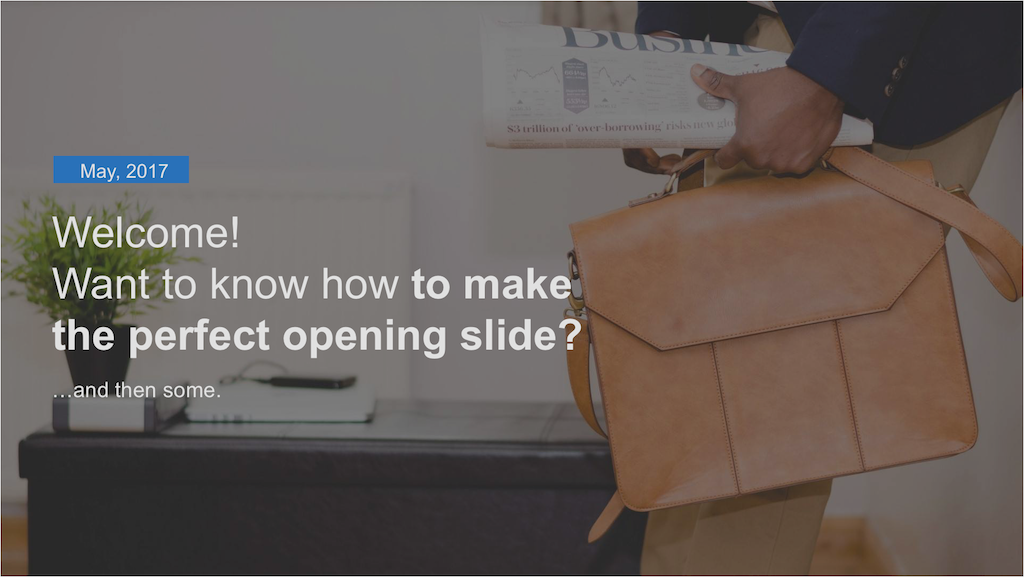
Use a welcoming presentation slide when people have come specifically to see you present.
Don’t use this if you’re presenting in the middle of other presentations, or when the audience have already seen something to do with your product or service that day.
21. Use a Physical Object
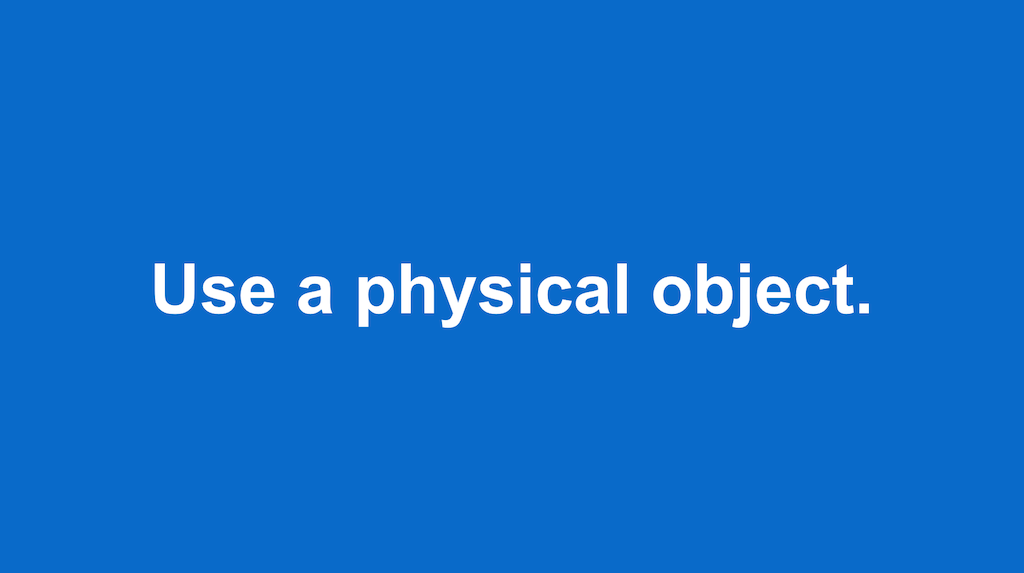
Bring an object along to your presentation that you think could be useful in your presentation, and start with explaining what it is, and why it is significant.
It could be a red ball, which you promise to toss at people who look like they’re going to fall asleep, or a product which you’re trying to sell. Either way, having an object in your opening is an unusual way of starting a presentation, and can get you some important points when presenting.
Use this if you’re presenting to a lively young audience instead of an opening presentation slide.
20. What If…
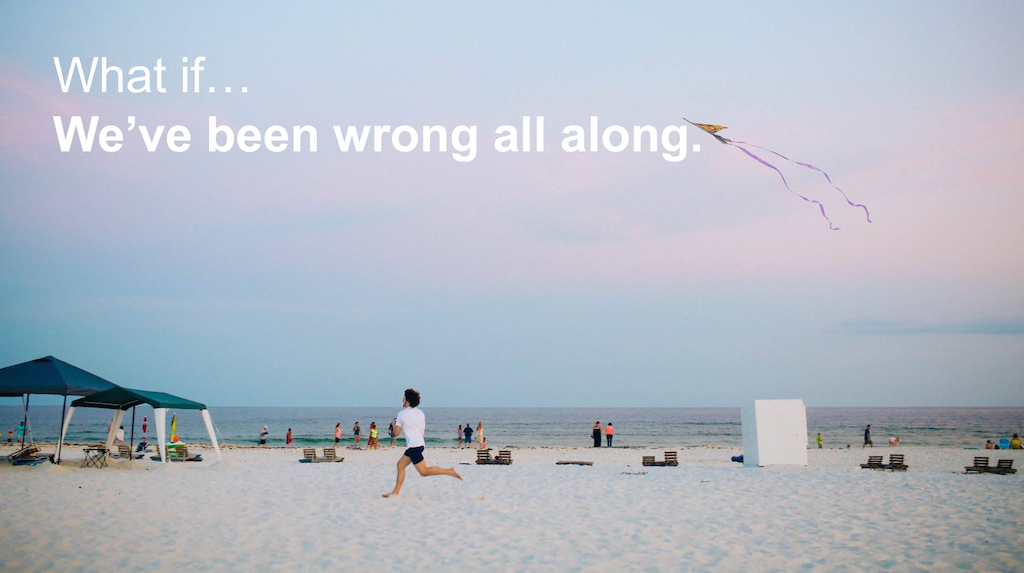
A good TED talk tactic. Use an imaginary scenario to get the audience to pay attention, and tickle their own abstract ideas about your subject.
Use this presentation slide if you have a hypothetical focus of your presentation, and you’re looking for input from the audience.
19. Show of Hands
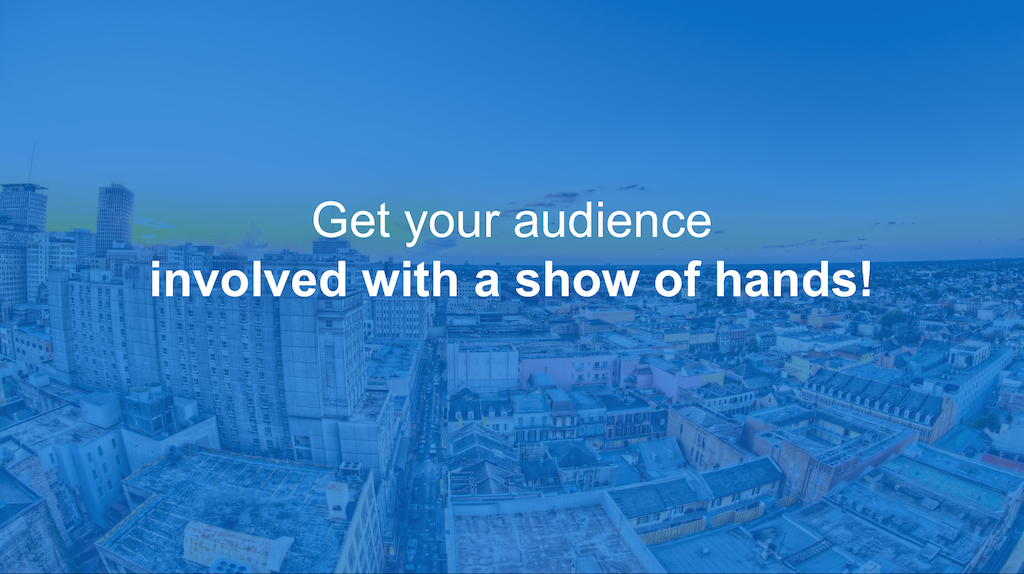
Ask the audience their opinion on something.
Often, this can break the ice between you and the audience, and get you feeling a little more comfortable before you start with your first presentation slide.
18. A Wise Man Once Said… (Or indeed woman!)
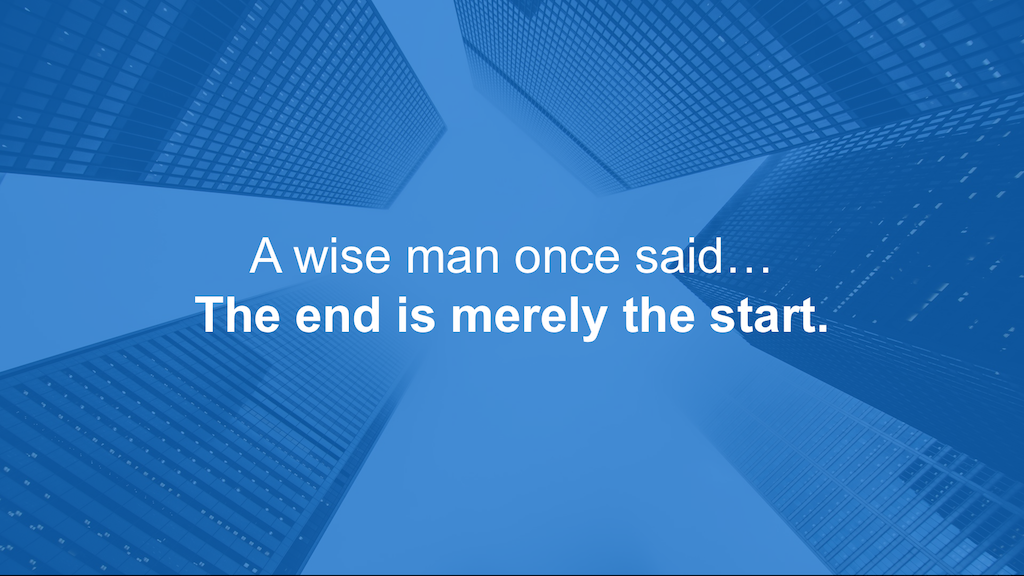
Use a famous quote as a point of reference.
This can be a good way to start a presentation if you think the audience need some context before your presentation, and can be an easy way in if you’re about to explain something complicated.
17. A Prelude.

Instead of starting off your presentation with an about me or history slide, try and tell the audience who you are, and what you’re about before you make the presentation.
One short story about what makes you a real person, and why they should listen to you speak can make a big difference in your confidence, and in the audiences’ faith in you.
16. Dramatic Pause…

You don’t need to use a presentation slide to kick off your speech.
Instead, start your presentation with 10 seconds of silence, and a blank powerpoint slide to heighten the audience anticipation.
15. Add some Glitz
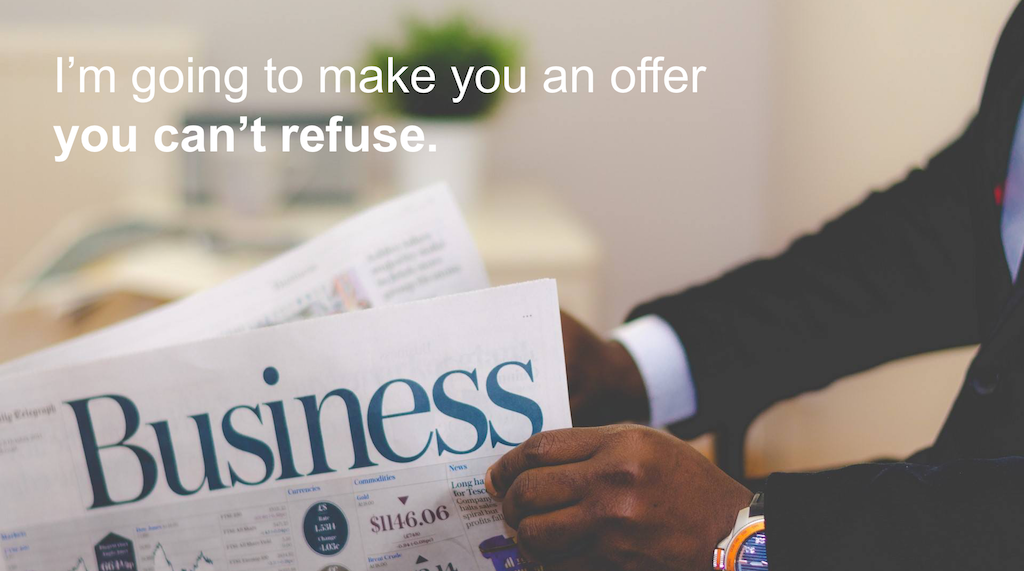
Quote a movie or a song in your first presentation slide to build rapport with your audience.
As long as it’s something that most of the audience will know, you’ll have them listening intently right from the get go!
This is especially important to consider when presenting to millenials.
14. A Number.
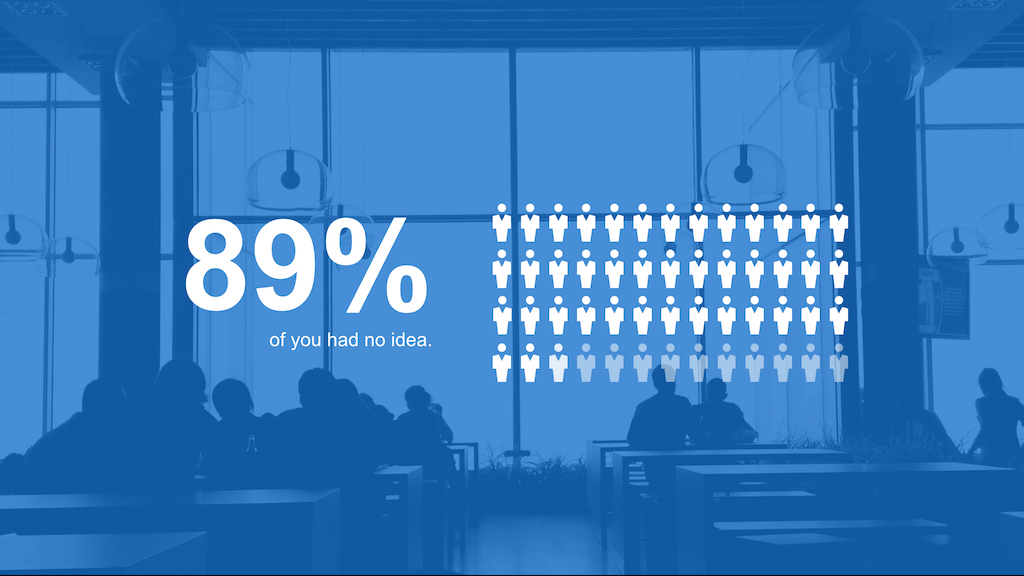
Open your speech with a statistical presentation slide.
A number can start your presentation right by giving your audience something tangible to understand.
If your presentation includes an interesting statistic, or you have an interesting point inside your presentation, show it off right at the start to keep your audience curious about how you arrived at that fact.
13. Make a Bold Claim
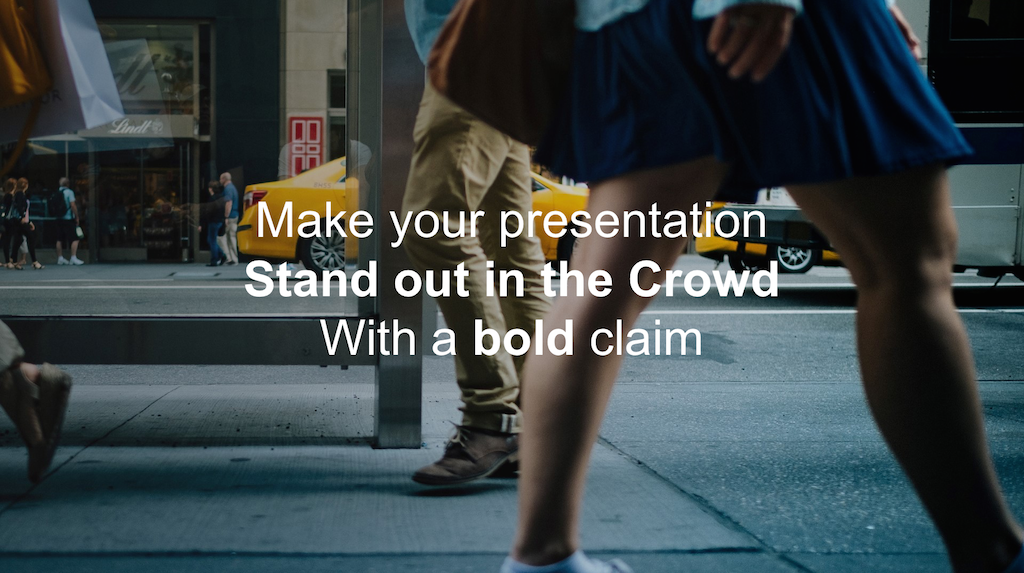
Controversial or elaborate hypotheses are often approached in presentations in an apologetic way, with a build up to the claim.
This is mostly due to nervous presenters to whom the idea of seeming silly at the start of a presentation puts them off using this as a tactic. Don’t be one of them!
12. Thank you
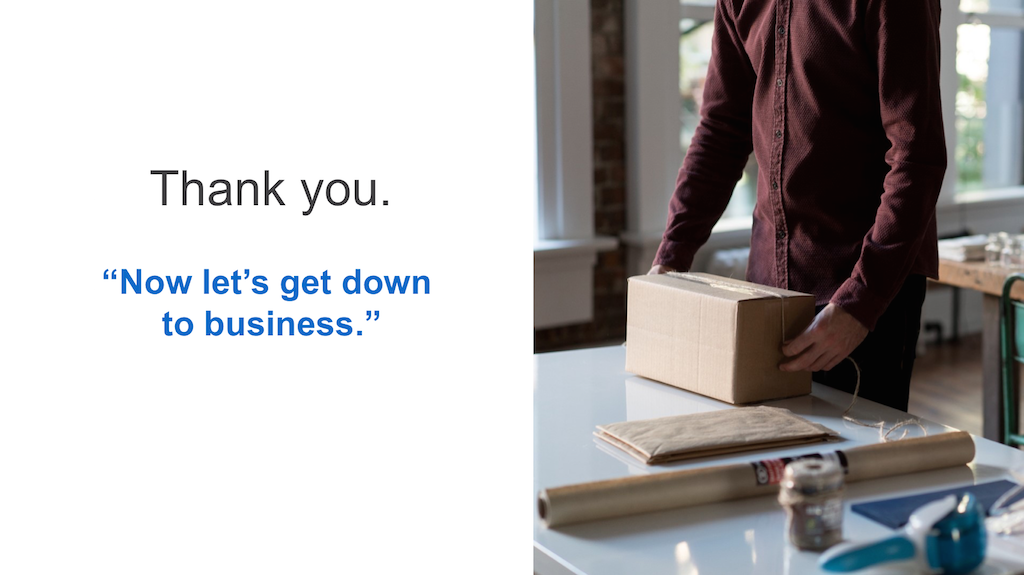
Another effective presentation slide opener is to thank the audience for being there.
Make them feel part of the presentation, and appreciated to get the best reaction from them later in your presentation.
11. Ask a Question
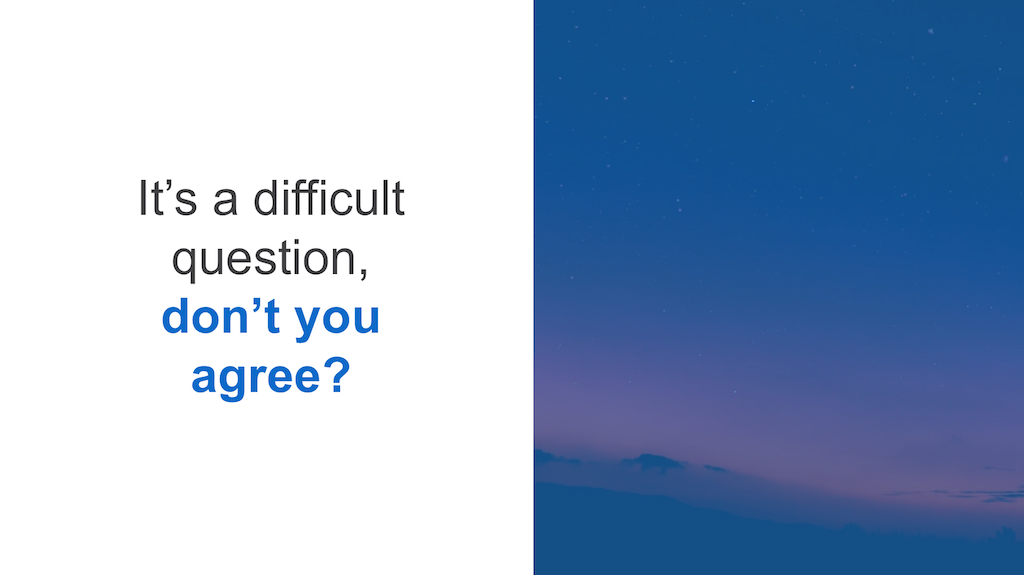
Start by asking your audience a difficult question about the topic to get a feel for the room.
Don’t ask them for a show of hands, but instead just ask them to think about it.
10. State their Problem

If you’re pitching to investors, focus on their problem. Try and relate your product or service to how their lives would be improved on your first presentation slide.
If they’re not the right audience, try and relate it their son, their daughter or their mother. Make it personal.
9. Grab their Attention
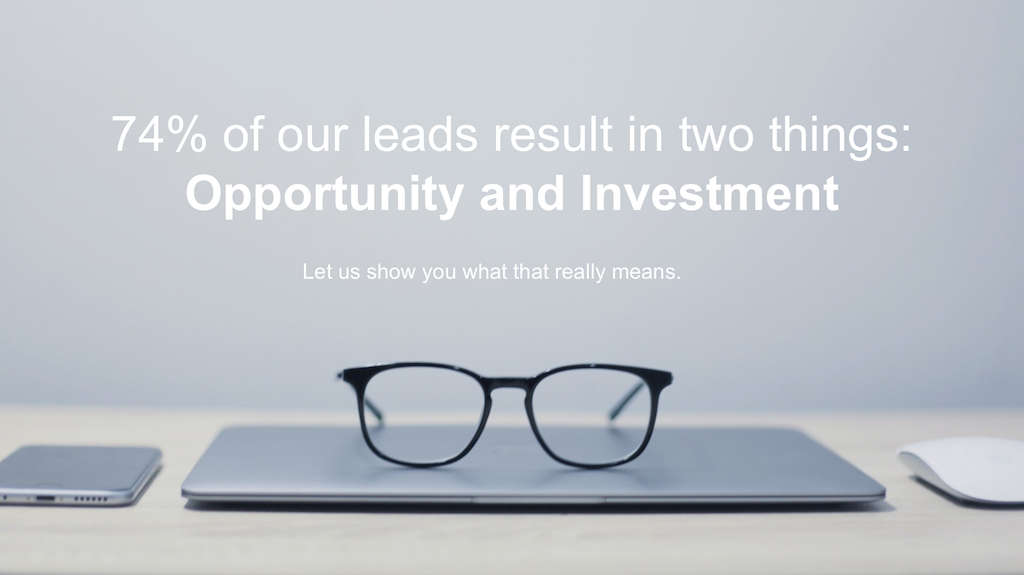
Do you have a shocking piece of information you’re going to present? Maybe you have an impressive statistic, or fact which you discovered or achieved.
Lead with something bold and colorful to grab their attention from the start.
8. Make Fun of Yourself
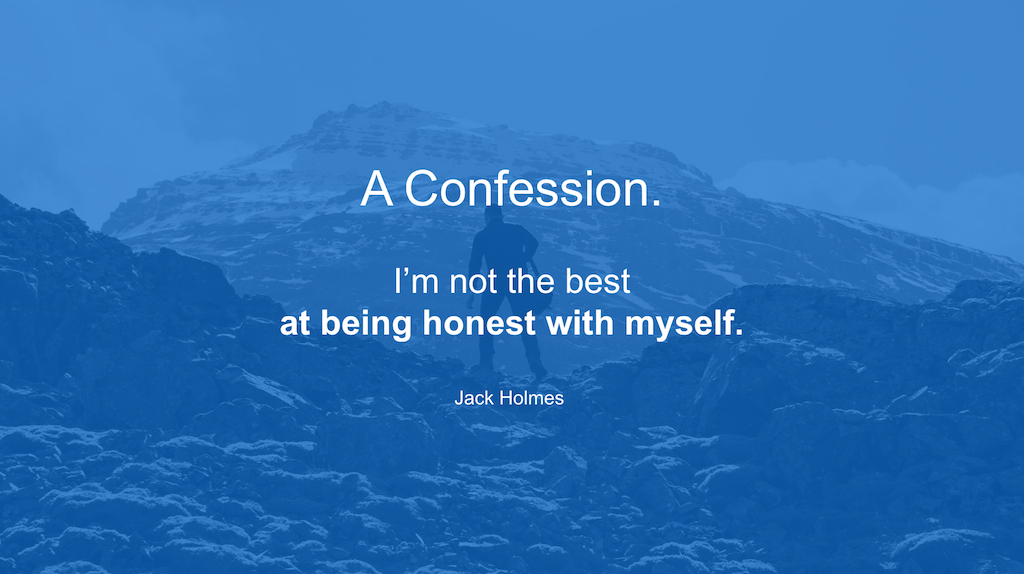
Be humble and approachable right from your first slide if you want to make a fantastic impression.
By showing the audience that you can make fun of yourself, and that you’re honest, you will knock down a little of the fourth wall between you and the people in front of you.
7. Use Curiosity
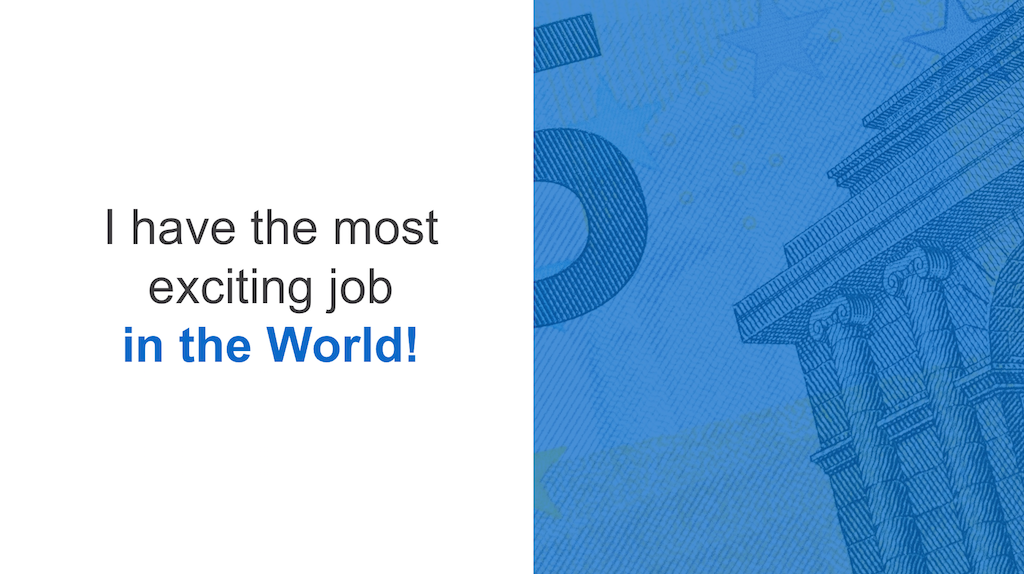
Using curiosity as a way to grab your audience’s attention is a good way to make you feel some power if you get nervous in presentations. Try something along the lines of: “I have the most exciting job in the world. No really, I do. Everyone I meet says “Wow, how do have the energy to do such a thing every day” , as i shrug, and take the compliment. Can you guess what i do? That’s right. I’m an accountant. ”
6. Look Back
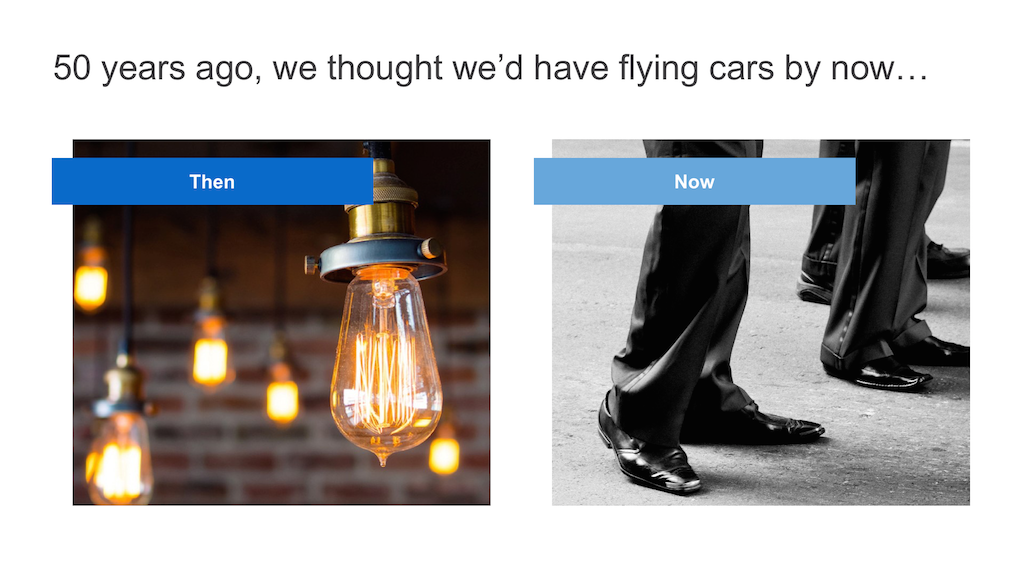
Refer to the past in your first presentation slide, and make a comparison of what humans thought the future would look like related to your presentation topic.
This can be a great way of getting the audience to feel like they already knew something about a difficult subject. It can also help to build connection between you and your audience by relating to a common belief.
5. Look Forward
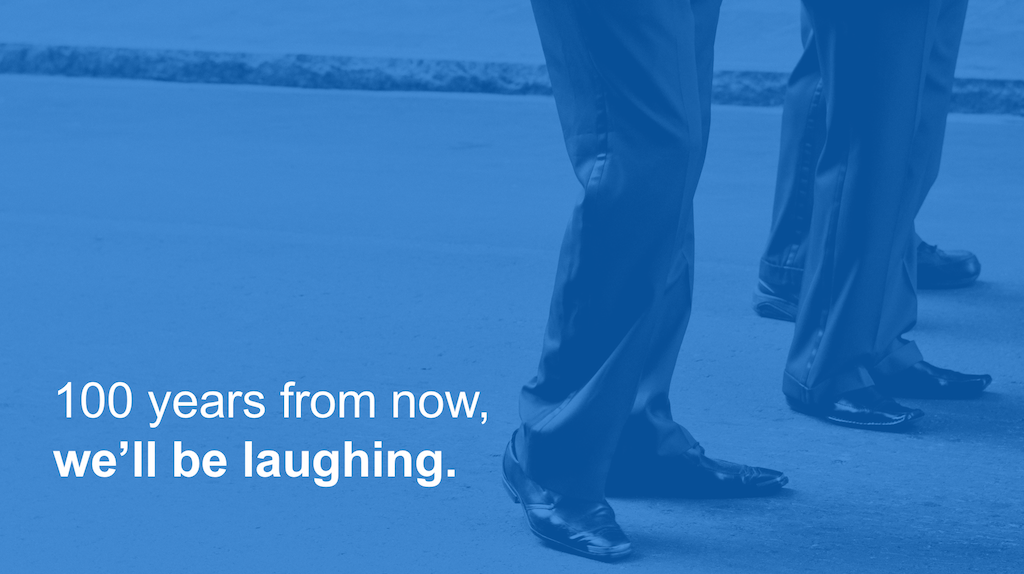
Open your presentation by referring to the future, and what you hope to achieve with your research, data, or pitch.
This is an impressive first presentation slide if you are trying to convince your audience to believe in something, whether that be a product, or a cause.
4. Use a Foreign Proverb
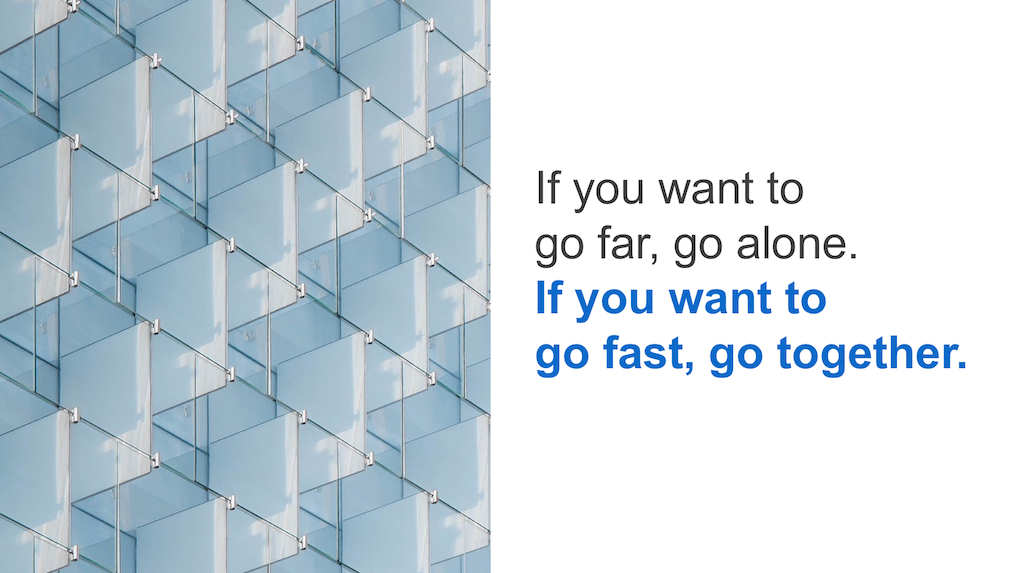
Using an english proverb might be a bit old hat in this day and age. Unless of course you’re going with the ‘dad joke’ ideal to millenials, in which case, press on!
Instead, use a proverb from a different language. There are some real gems out there, and can impress your audience that you’ve gone to the research trouble.
3. Refer to Current Events
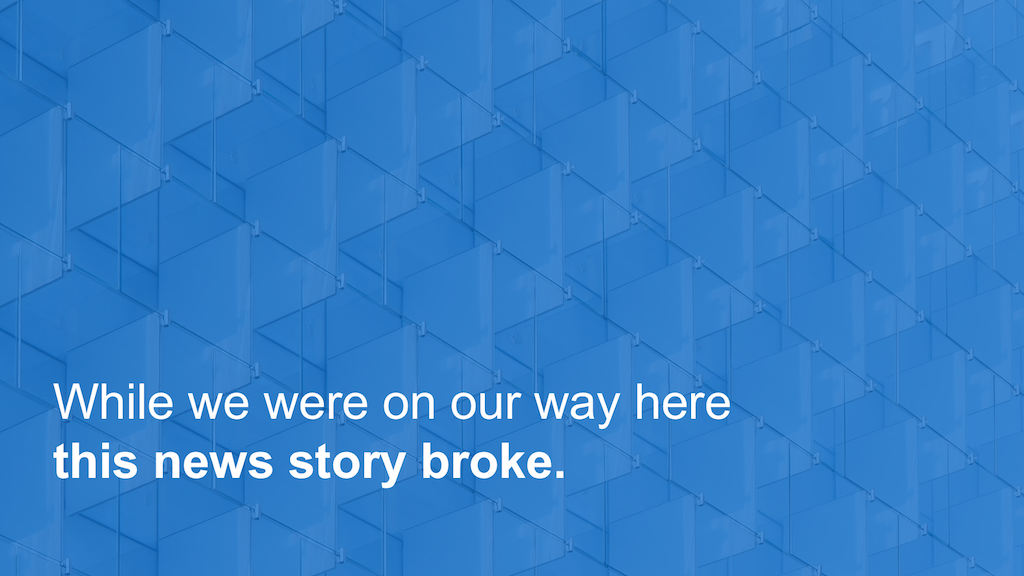
If, on the day you’re due to present you read about an interesting current events story, or news article which links to your presentation, use it as your opening!
Discussing a current events article will show the audience your intellect and also get them understanding you from the get go.
2. Refer to a Historical Event
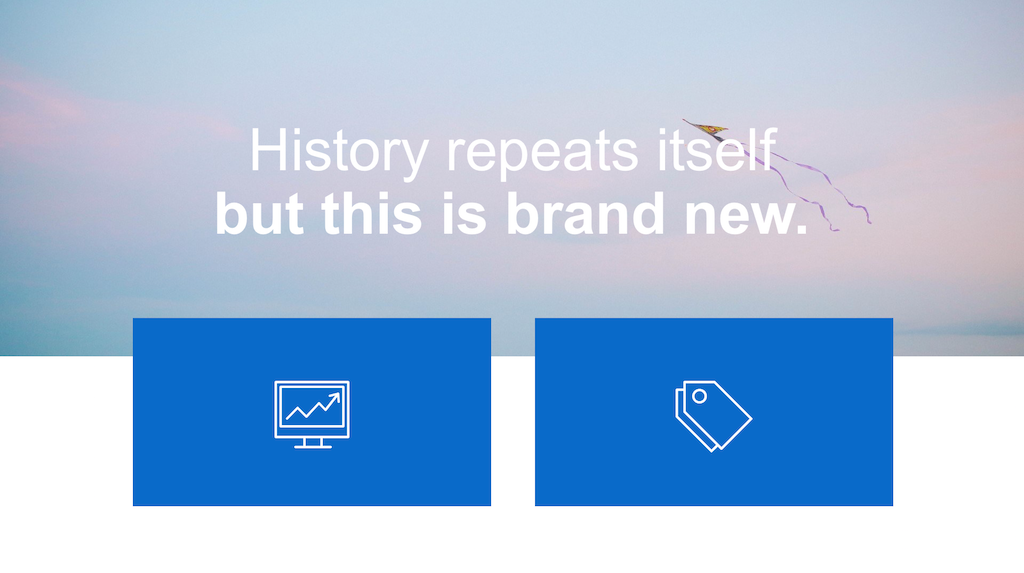
If you’re presenting something really fantastic, comparing your presentation to something significant in the past can be a good way of building some hype.
Of course, if you’re building something which isn’t that revolutionary, try adapting this opening into a humorous comparison instead, and build some rapport with your audience.
1. Tell a Story
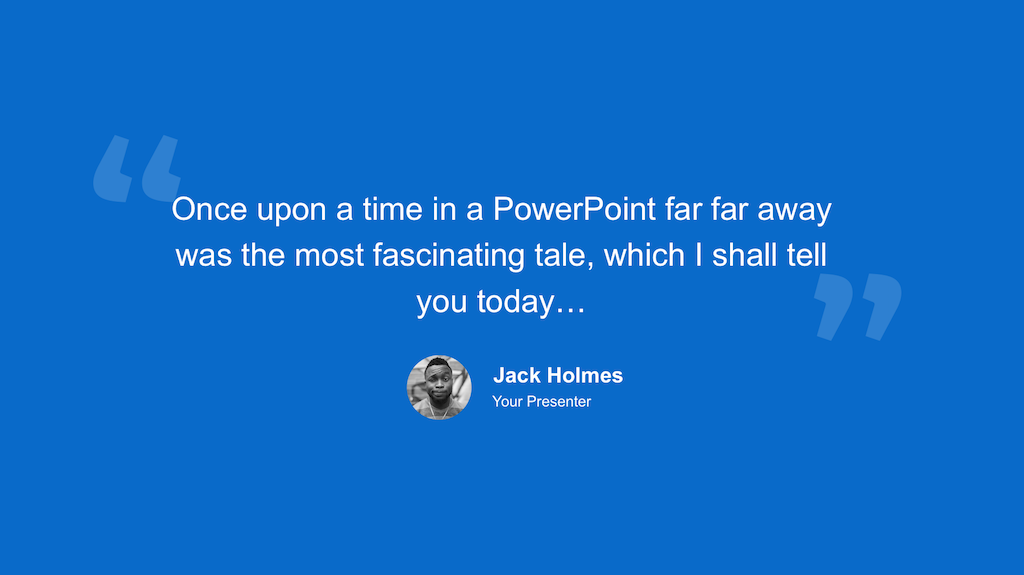
The best way to start a powerpoint presentation is to start is with a story.
A thoughtful story along with a link to your presentation will get you off on the right foot
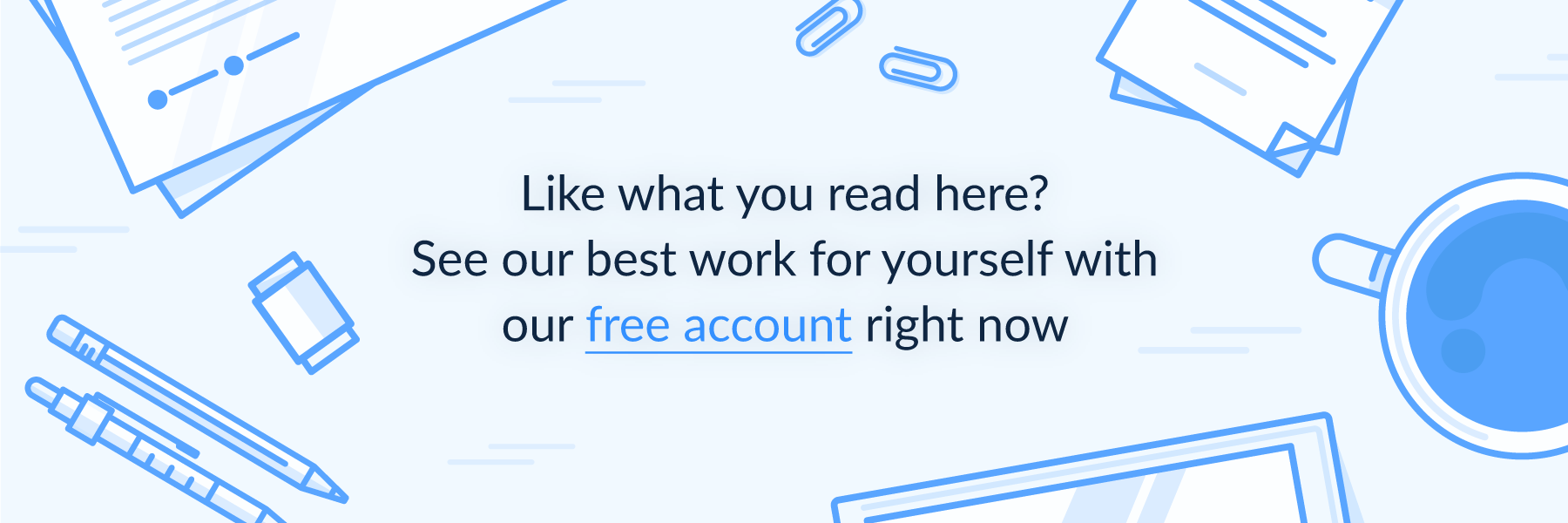
Get awesome presentation content in your inbox every week
It only takes a click to unsubscribe.
2018 © SlideCamp

10 presentation opening ideas to capture audience attention
Capturing your audience’s attention right at the beginning is vitally important any successful presentation. According to new research , a powerful opening helps listeners stay engaged with the presentation throughout.
However, delivery and slide management is as important as the content you wish to share. In this post, we will be looking at some interesting, proven ways to engage your audience right from the get-go.
The what, how, and why
Many presenters often focus on the “what” and straight away jump to the “how” of their topic. However, it is important to focus on the “why” as well. Emphasize why there is a need to address the topic you are about to discuss.
Imagine you are giving a presentation on “The Benefits of Remote Work” and how to incorporate it using technology. Instead of just focusing on how you will go about working remotely, add some slides explaining why there is a need for remote work. This can add more context to your topic and help listeners understand the solution you offer more clearly.
Stimulate original thoughts
You can start your talk by asking your audience to imagine a scenario related to the core idea of your presentation. Viewing the topic from their perspective can help the audience relate a lot better to your narrative.
For instance, you can ask the audience to imagine eating their favorite continental food. This can be followed up with introducing a new app to deliver different international cuisine items at affordable prices. The imagination helps your listeners visualize the benefit they could enjoy by using the app.
Use a captivating visual

Using an engaging visual at the start can be a compelling way to start your slides. This can be a video, an intuitive chart, or even an infographic. It takes less time and cognitive effort for an average viewer to comprehend something visual than just plain text.
For instance, if you are going to present about climate change and its effects, a video about the impact it has on wildlife would strike a chord better than information given through text.
Intriguing start

Building intrigue at the start can be a powerful way to incorporate your ideas and get your participants thinking. With this approach, you can place a single word, number, or a statistic in the first slide of your presentation. This helps build curiosity among participants and stimulate a discussion too.
Using a powerful quote

While words might not always have the impact visual content does, there are some tried and tested lines that will probably work. For instance, adding a great quote relevant to the presentation topic can add credibility and context to the message you are trying to deliver.
For instance, the slide shown above can be used as an opening slide for an ad agency’s pitch. It is punchy, direct, and relates to the company being presented to.
Be a storyteller
Human beings, in general, are wired to pay attention to stories. Use a story that is related to your presentation and why you’re presenting that topic. If applicable, you can tell short, memorable anecdotes from your life experiences to capture the attention of the audience.
Ask a thought-provoking question
Questions can get the speaker and audience better acquainted with each other before the presentation. They are one of the most interactive ways to start a presentation.
Rhetorical questions are usually used to draw the attention of the audience and get them to form an opinion. Just be sure that the question sets them on course to agreeing with the core message of your presentation.
Involve your audience
You can get your audience involved by posing a question and asking for a show of hands. For instance, you can ask a question like “how many of you had breakfast this morning?” You can then bring up a statistical insight that “1 in 5 working professionals skip breakfast and start the day with an unhealthy habit. Our team is striving towards finding ways to bring this number down. This would be welcome news for those that did not put your hand up.”
Start with a bold headline

Use a surprising statistic or a shocking claim to capture the attention of your audience. This is similar to starting with a question—just ensure it directly relates to the topic discussed in the presentation and supports the message you will be delivering.
If you are planning to include statistics, make sure to include the source of the information. Citing a reputable source of information will help increase the credibility of your presentation. In this example above, the statistic about increasing electronic waste will make the audience take note and act on the message you are about to deliver about recycling e-waste.
Kick off with a joke
Humor is always an effective way to break the ice with your participants. A joke can be used to introduce the topic of your presentation. Adding humor generates positive feelings among your audience and helps hold their attention for the duration of your presentation.
Some great presenters, like Steve Jobs, did not start their presentations with a generic introduction slide or a list of numbers. These presenters do a lot more and get the attention of the audience using innovative methods, like some of them listed above. Try these different techniques to find out the one that works best for you and incorporate it in your next presentation.
Product Marketer
Leave a Reply Cancel reply
Your email address will not be published. Required fields are marked *

Related Posts
How to Start a Presentation | 13 Golden Presentation Openers to Wow Audience in 2024
Lawrence Haywood • 05 April, 2024 • 21 min read
What are the perfect presentation openers? Did you know this? Knowing how to start a presentation is knowing how to present .
No matter how brief, the first moments of your presentation are a huge deal. They have a massive impact not only on what follows but also on whether or not your audience follows along with you.
Sure, it’s tricky, it’s nerve-wracking, and it’s crucial to nail down. But , with these 13 ways to start a presentation and appealing presentation starting words, you can captivate any audience from your very first sentence.
Table of Contents
- Ask a Question
- Introduce as a Person
- Tell a Story
- Give a Fact
- Be Super Visual
- Use a Quote
- Make ’em Laugh
- Share expectations
- Poll your audience
- Live polls live thoughts
- Two Truths and A Lie
- Flying challenges
- Super competitive Quiz Games
Frequently Asked Questions
More tips with ahaslides.
- How to write a presentation
- Presentation Description

Start in seconds.
Get free templates for your next interactive presentation. Sign up for free and take what you want from the template library!
1. Ask a Question
So, how to start a speech presentation? Let me ask you this : how many times have you opened a presentation with a question?
Furthermore, have you ever wondered why an immediate question might be a great way to start a presentation?
Well, let me answer that one. Questions are interactive , and interactive presentation is what audiences bored to death of one-way monologues crave the most.
Robert Kennedy III , the international keynote speaker, lists four types of questions to use right at the beginning of your presentation:
While these questions might be engaging, they’re not really questions, are they? You don’t ask them in the hope that your audience will stand up, one-by-one, and actually answer them.
There’s only one thing better than a rhetorical question like this: a question that your audience truly answers , live, right in the moment.
There’s a free tool for that…
AhaSlides lets you start your presentation with a question slide, then gather actual answers and opinions from your audience (via their phones) in real-time. These questions can be word clouds , open-ended questions , rating scales , live quizzes , and so much more.
Not only does opening in this way get your audience immediately paying attention in starting a presentation, it also covers some of the other tips mentioned in this article. Including …
- Getting factual – Your audience’s responses are the facts.
- Making it visual – Their responses are presented in a graph, scale or word cloud.
- Being super relatable – The audience is fully involved in your presentation, both from the outside and the inside.

Create an Active Audience.
Click below to make a fully interactive presentation for free on AhaSlides.
Kich off the right way
2. Introduce Yourself as a Person, not a Presenter
How to start a presentation about yourself? What things to include in an about me presentation? Some great, all-encompassing advice on how to introduce yourself in a presentation comes from Conor Neill , serial entrepreneur and president of Vistage Spain.
He likens starting a presentation to meeting someone new at a bar. He’s not talking about quaffing 5 pints beforehand to establish Dutch courage; more like introducing yourself in a way that feels friendly, natural and most of all, personal .
- Introduce team member
- How to introduce yourself
Imagine this : You’re in a bar where someone piqued your interest. After a few furtive glances, you build up the courage and approach them with this:
Hi, I’m Gary, I’ve been an economic biologist for 40 years and I want to talk to you about the microeconomics of ants . – Your introduction slide about yourself ! And you’re going home alone tonight.
No matter how attractive your topic is, no one wants to hear the far-too-commonly-used ‘ name, title, topic’ procession, as it offers nothing personal to latch onto.
Imagine this : You’re in the same bar a week later, and someone else has piqued your interest. Let’s try this again, you think, and tonight you go with this:
Oh hey, I’m Gary, I think we know someone in common… – You , establishing a connection .
This time, you’ve decided to treat your listener as a friend to be made rather than as a passive audience. You’ve introduced yourself in a personal way that has made a connection and has opened the door to intrigue.
When it comes to introduction ideas for presentation, we recommend checking out the full ‘How to start a presentation’ speech by Conor Neill below. Sure, it’s from 2012, and he makes some dust-coated references to Blackberries, but his advice is timeless and incredibly helpful. It’s a fun watch; he’s entertaining, and he knows what he’s talking about.
3. Tell a Story – How to Start a Speech Off
How to start an introduction for a presentation? If you did watch the full video above, you’d know that Conor Neill’s absolute favourite tip for starting a presentation is this: telling a story .
Think about how this magical sentence makes you feel:
Once upon a time…
For pretty much every child that hears these 4 words, this is an instant attention grabber . Even as a man in his 30s, this opener still makes me wonder what might follow.
Just on the off-chance that the audience for your presentation isn’t a room of 4-year-olds, don’t worry – there are grown-up versions of ‘once upon a time’ .
And they all involve people. Just like these:
- “The other day, I met someone who completely changed my thinking…”
- “There’s a person at my company who once told me….”
- “I’ll never forget this customer we had 2 years ago…”
Remember this 👉 Good stories are about people ; they’re not about things. They’re not about products or companies or revenue; they’re about the lives, the achievements, the struggles and the sacrifices of the people behind the things.

Aside from conjuring an immediate surge of interest by humanising your topic, there are several other benefits to starting a presentation with a story:
- Stories make YOU more relatable – Just like in tip #2 , stories can make you, the presenter, seem more personal. Your experiences with others speak far louder to audiences than stale introductions of your topic.
- They give you a central theme – Though stories are a great way to start a presentation, they also help to keep the entire thing cohesive. Calling back to your initial story at later points in your presentation not only helps to solidify your information in the real world but it also keeps the audience engaged through the narrative.
- They’re jargon busters – Ever heard a children’s story that starts with ‘ once upon a time, Prince Charming drilled down on the actionability principle inherent in agile methodology ‘? A good, natural story has inherent simplicity that any audience can understand.
💡 Going virtual with your presentation? Check out seven tips on how to make it seamless !
4. Get Factual
There are more stars in the universe than there are grains of sand on earth.
Did your mind just explode with questions, thoughts and theories? That’s how to start a presentation, as the best way for the powerpoint Presentation Introduction!
Using a fact as an opener to a presentation is an instant attention grabber.
Naturally, the more shocking the fact is, the more your audience is drawn to it. While it’s tempting to go for pure shock factor, facts need to have some mutual connection with the topic of your presentation. They need to offer an easy segue into the body of your material.
Here’s an example I recently used at an online event ran from Singapore 👇 “In the U.S alone, around 1 billion trees’ worth of paper are thrown away yearly.”
The speech I was giving was about our software, AhaSlides, which provides ways to make presentations and quizzes interactive without using stacks of paper.
Though that’s not the biggest selling point of AhaSlides, it was super easy for me to connect that shocking statistic and what our software offers. From there, segueing into the bulk of the topic was a breeze.
A quote gives the audience something tangible , memorable and understandable to chew on, all while you proceed into a presentation that will likely be a series of more abstract ideas.
5. Make it Visual – How to Introduce a Topic in a Presentation
There’s a reason I chose the GIF above: it’s a mix between a fact and an engaging visual .
While facts grab attention through words, visuals achieve the same thing by appealing to a different part of the brain. A more easily stimulated part of the brain.
Facts and visuals usually go hand-in-hand regarding how to start a presentation. Check out these facts about visuals:
- Using images endears you to the 65% of people who are visual learners. ( Lucidpress )
- Image-based content gets 94% more views than text-based content ( QuickSprout )
- Presentations with visuals are 43% more persuasive ( Venngage )
It’s the last stat here that has the most significant implications for you.
Think about this 👇 I could spend all day telling you, through voice and text, about the impact of plastic on our oceans. You may not listen, but the chances are that you will be more convinced by a single image:

That’s because images, art in particular, are way better at connecting to your emotions than I am. And connecting to emotions, whether through introductions, stories, facts, quotes or images, gives a presentation its persuasive power .
On a more practical level, visuals also help make potentially complex data super clear. While it’s not a great idea to start a presentation with a graph that risks overwhelming the audience with data, visual presentation material like this can certainly be your best friend later on.
6. Use a Solitary Quote – How to Start off a Presentation Speech
Like a fact, a single quote might be the best way to start a presentation as it can add a vast deal of credibility to your point.
Unlike a fact, however, it’s the source of the quote that often carries a lot of the gravitas.
The thing is, literally anything anyone says can be considered a quote. Stick some quotation marks around it and…
…you’ve got yourself a quote. Lawrence Haywood – 2021

Starting a presentation with a quote is pretty great. What you want is a quote that starts a presentation with a bang. To do that, it has to check these boxes:
- Thought-provoking : Something that gets the audience’s brains working the second they hear it.
- Punchy : Something 1 or 2 sentences long and short sentences.
- Self-explanatory : Something that requires no further input from you to aid understanding.
- Relevant : Something that helps you segue into your topic.
For mega-engagement, I’ve found it’s sometimes a good idea to go with a controversial quote .
I’m not talking about something completely heinous that gets you thrown out of the conference, just something that doesn’t encourage a unilateral ‘nod and move on’ response from your audience. The best opening words for presentations might come from controversial opinions.
Check this example 👇 “When I was young, I thought that money was the most important thing in life. Now that I am old, I know that it is” – Oscar Wilde.
This certainly isn’t a quote that elicits total agreement. Its controversial nature offers immediate attention, a great talking point and even a way to encourage audience participation via a ‘how much do you agree?’ question ( like in tip #1 ).
7. Make it Humorous – How to make a Boring Presentation Funny?
One more thing a quote can offer you is the chance to get people laughing .
How many times have you, yourself, been an unwilling audience member in your 7th presentation of the day, needing some reason to smile as the presenter plunges you head-first into the 42 problems of stopgap solution bring ?
Humour takes your presentation one step closer to a show and one step further from a funeral procession.
Aside from being a great stimulator, a bit of comedy can also give you these benefits:
- To melt the tension – For you, primarily. Kicking off your presentation with a laugh or even a chuckle can do wonders for your confidence.
- To form a bond with the audience – The very nature of humour is that it’s personal. It’s not business. It’s not data. It’s human, and it’s endearing.
- To make it memorable – Laughter has been proven to increase short-term memory. If you want your audience to remember your key takeaways: make ’em laugh.
Not a comedian? Not a problem. Check out these tips on how to start a presentation with humour 👇
- Use a funny quote – You don’t have to be funny if you quote someone who is.
- Don’t crowbar it – If you’re finding it difficult to think of a funny way to start your presentation, just leave it. Forced humour is the absolute worst.
- Flip the script – I mentioned in tip #1 to keep introductions away from the over-flogged ‘name, title, topic’ formula, but the ‘name, title, pun’ formula can funnily break the mould. Check out below what I mean…
My name is (name) , I am a (title) and (pun) .
And here it is in action:
My name is Chris, I’m an astronomer and lately my whole career has been looking up. You, getting off on the right foot
8. Share expectations – Best Way to Open a Speech
People have different expectations and background knowledge when they attend your presentations. Knowing their objectives can provide a value that you can use to adjust your presenting style. Adapting to people’s needs and meeting the expectations of everyone can result in a successful presentation for all involved.
You can do this by holding a small Q&A session on AhaSlides . When you start your presentation, invite attendees to post the questions they are most curious about. You can use the Q and A slide pictured below.
Some questions that I am happy to be asked:
9. Poll your audience – Different Way to Present a Presentation
This is another easy way to boost the excitement levels and creativity of everyone in the room! As the host, split the audience into pairs or trios, give them a topic and then ask teams to make a list of possible responses. Then have each team submit their answers as fast as possible to a Word Cloud or Open-Ended question panel on AhaSlides . The results will show up live in your slide show!
The topic of the game does not need to be the topic of the presentation. It can be about anything fun but provokes a lighthearted debate and energises everyone.
Some suggested topics are:
- Three ways to name a group of animals (Eg: a cupboard of pandas, etc.)
- Best characters in the TV show Riverdale
- Five alternative ways to use a pen
Get free templates to wow your audience with a great introduction in your next presentation. Sign up for free and take what you want from the template library!
10. Live polls, Live thoughts
If you’re worried that the above games have too much “typing”, then an icebreaker with a live poll will capture everyone’s attention but take much less effort. The questions can be funny and silly, industry-related, and debate-prompting, and are designed to get your audience networking.
Another idea is to start with easy-going, essential questions and move on to trickier ones. In this way, you lead the audience toward the topic of your presentation and thereafter, you can build up your presentation based on these questions.
Don’t forget to organise the game on an online platform like AhaSlides . By doing this, responses can be displayed live on the screen; everyone can see how many people think like them!
🎊 Tips: Use the idea board to organise your options better!

11. Two Truths and A Lie – Another Way of ‘Get to know Me Presentation’
Spin more fun to your session! This is a classic icebreaker game with a straightforward rule. You have to share three facts, only two of which are true, and the audience must guess which one is the lie. The statements can be about you or the audience; however, if attendees have never met before, you should give out prompts about yourself.
Collect as many sets of statements as possible, then create an online multiple-choice poll for each one. On D-Day, present them and let everyone vote on the lie. Tip: Remember to hide the correct answer till the end!
You can get ideas for this game here .
Or, check out the ‘real’ Get to Know me Games
12. Flying challenges
Icebreakers mostly center around you – the presenter – handing out questions and requests to the audience, so why not mix it up and have them take turns challenging each other? This game is a physical task that gets people moving. It’s a beautiful way to rock the whole room and get people interacting.
Give out paper and pens to the audience and ask them to think of challenges for the others before crumpling them into balls. Then, count down from three and throw them into the air! Ask people to grab the one nearest them and invite them to read the challenges.
Everyone loves winning, so you can’t imagine how challenging this can be! The audience will be even more motivated if you put up a prize for the most exciting questions!
13. Super competitive quiz games
How to make a presentation fun? Nothing can beat games at hyping people up. Knowing this, you should have your audience jump straight into a fun quiz at the beginning of your presentation. Wait and see how energised and hyped up they become!
The best thing: This is not limited only to entertaining or easy-going presentations, but also more “serious” formal and scientific ones. With several topic-focused questions, attendees can get a clearer insight into what ideas you are about to bring them while becoming more familiar with you.
If you are successful, the preconception that a presentation must be painstakingly nerve-wracking disappears almost immediately. All that is left is pure excitement and a crowd eager for more information.
Need more interactive presentation ideas ? AhaSlides got you covered!
Why is it Important to Start a Presentation Effectively?
Starting a presentation effectively is crucial because it sets the tone for the entire presentation and can capture the audience’s attention and interest. If you fail to engage your audience at the beginning, they may quickly lose interest, be bored and tune out, making it difficult to get the message across effectively.
Unique ways to start a presentation?
A few ways to make it unique include Telling a Story, Starting with a Surprising Statistic, Using a Prop, Beginning with a Quote or Starting with a Provocative Question!
Three keys to a Successful Presentation
Engaging Opener, Inspiring Stories with a Clear Call to Action
Starting lines of presentation?
Good morning/afternoon everyone, welcome to my presentation Let me start by saying a few words about myself. As you can see, our main topic for today is…… This talk is designed to …
When a quotation is used in a presentation you should…
Cite every source clearly, during speaking, in handouts to participants and also on the slides.
Bonus Download! Free Presentation Template
Make it interactive

Lawrence Haywood
Former ESL teacher and quiz master converted to the wild slide. Now a content creator, traveller, musician and big time slider preaching the good word of interactivity.
Tips to Engage with Polls & Trivia
More from AhaSlides

How to Open and Close a Presentation in 8 Memorable Ways

What makes an exceptional presentation? Obviously, it needs to provide plenty of data to support the presenter’s primary objective. But, believe it or not, the heart of a presentation— the gist, the meat, the essence of it— isn’t what makes audiences sit up and take notice.
It doesn’t matter how flashy or informative a presentation (even one designed with a PowerPoint alternative ) might be. It’s a strong opening and closing that will make an audience care. Without these key elements— and slides to represent each— all the research and preparation put into a presentation are for naught. An effective presentation will start out strong and end on a powerful note.
Attracting audience members’ attention from the beginning of your presentation is vital if there’s any hope of getting them to care about what you have to say. Once they’ve tuned you out, it’s all over. Therefore, make a bold statement, intrigue them and stimulate their curiosity of what will come next.
According to Darlene Price , president of Well Said Inc., and author of, “Well Said! Presentations and Conversations That Get Results,” when we speak, we only have about 60 seconds to capture an audience's attention, establish our credibility, familiarize the audience to our topic and motivate it to listen.
“You need to put the art in the start — the most important part of the work,” Price told Business Insider.
At the same time, the end of a presentation is the best chance to leave a lasting impression on an audience. Don’t just describe your final point and then let your presentation trail off, leaving audiences to guess when you’re done. A powerful presentation ending will include calls to action, visions of the future and words to live by.
Do you have plenty of content and professionally-designed slides for your presentation, but need some help opening and closing with a bang? Check out these eight memorable ways to open and close a presentation.
1. Start with a, “Thank you,” instead of ending with one.
Instead of ending your presentation with a thank you, try starting with one. By welcoming your audience and thanking it for attending your presentation, for giving you the opportunity to speak or make a pitch to it, you start the whole thing off with a positive first impression.
This step of public speaking not only shows your sincerity, but it also establishes a sense of respect, trust and community with your audience. Plus, by showing your appreciation in the beginning, you leave yourself room to end with a strong call to action.
2. Hook your audience with a bold statement.
Get your audience on board with listening by making a bold statement to hook its attention. A confident assertion signals confidence and peaks the audience’s interest, but don’t make a statement that is just crazy or serves no other purpose than providing shock value.
Whatever the statement, the rest of your presentation has to back it up. Examples of strong hooks include short, yet surprising or motivational stories, thought-provoking analogies or metaphors, shocking statistics related to the presentation topic or even unique yet inspiring quotes by well-known figures from the past or present.
3. Transition between presentation points.
It’s easy for audience members to lose focus in between stages of even the most titillating presentations. Using strong linking and transitional phrases help bring them back around. These statements are the glue that holds a presentation together.
Strategic transitions will help an audience move from one idea to the next. To bridge the gap between a hook and the rest of the presentation, try asking, for example, open-ended and rhetorical questions that push the audience to ponder about what is coming next.
Make eye contact with your audience members and make sure they are still engaged with the information you’re presenting. Carefully-chosen transitions are powerful ways to not only introduce the next segment, but also pull in an audience’s attention all over again.
4. Tell a personal story.
Telling a brief, personal story early in a presentation is an effective way to connect with an audience . When people hear the speaker tell his or her own story, they tend to pay attention.
Plus, telling a 60- to 90-second narrative shows the audience you’re invested in the topic and opens an opportunity to show you’re passionate about the information you’re presenting. If you don’t have any personal experience with the topic, you can substitute a historic story, a fable or an anecdote, instead.
Be sure to follow a story arc, including a main character, a challenge or obstacle relating to the presentation topic, a tale of how that challenge was overcome and what lessons were learned by the protagonist that can also be applied to the audience.
5. Show the audience how it benefits.
Why should the audience care? You’ve grabbed its attention with a hook, and you’ve transitioned to a personal story to which it can relate. Now you want to engage audience members with how the advice or plan presented will benefit them, their business, their loved ones or their financial stability.
Don’t assume the audience already knows. This is also an optimal opportunity to show the audience, not simply stop with telling it. Using a sense of optimism, paint a vivid picture of the future benefits with descriptive and emotional words. Once the audience envisions the positive outcome, it will start to believe in the possibility.
6. Summarize key takeaways.
After you’ve presented the primary content, it’s important to summarize the presentation’s key takeaways before transitioning to a strong end. Let the audience know you’re starting to wrap things up, and make sure it’s on board with what it should take away from the presentation, using simple, straightforward language.
Often, savvy presenters will break down their content to three takeaways and summarize those, but others will round off their message by referencing back to the opening hook. Doing so not only summarizes the presentation, but also completes the circle of the topic, connecting back to the start.
If a question was posed in the opening, it can be answered in the takeaway. It can also be a prime opportunity to explain the moral of a story told earlier in the presentation.
7. End with an ask.
Any effective presentation will feature a call-to-action toward the end. What was your purpose for giving the presentation, and what do you want the audience to do after receiving your message?
Again, don’t assume the audience automatically knows the desired next step, and don’t use overly flowery language that leaves any room for imagination. Be clear and concise. The clearer and more specific the call-to-action, the more people will take the advice.
8. Finish with a clincher.
Many speakers will end their presentations with the call to action. But we also like to finish everything off with a clincher— one last story, compelling statistic or inspirational quote that serves as the cherry on top of an ice cream presentation.
Don’t take this opportunity to summarize the previous content; another rehashing will just bore both the speaker and the audience. Instead, end the presentation with humor or inspiration. Find a relative and memorable yet unique quotation or story from master storytellers like Mark Twain or Steve Jobs, presenters who often left audiences with ideas to ponder long after they parted company.
Including a statement so profound that it later turns into a soundbite or a meme can extend the presentation’s life far beyond its scheduled time frame. The clincher is also an effective ending slide to a visual presentation.
What elements do you most use when developing effective presentation openings and closings?

Samantha Pratt Lile
Samantha is an independent journalist, editor, blogger and content manager. Examples of her published work can be found at sites including the Huffington Post, Thrive Global, and Buzzfeed.
Recommended Articles
Kick the year off with these 3 productivity-boosting presentation features, three ways to use presentation software to help students study for tests, how to keep your audience engaged and when to get it involved, how to nail your presentation in a pinch.

Improve your practice.
Enhance your soft skills with a range of award-winning courses.
How to Start a Presentation and Engage your Audience
June 27, 2018 - Dom Barnard
Why should you focus on the start of your speech? Because many studies show that if you can capture someone’s interest straight away, there’s a good chance they’ll listen to the rest of the presentation. If you don’t, the majority of listeners will focus on something else.
This article discusses different ways to start a presentation and keep your audience engaged, as well as example videos you can watch which illustrate these points.
Beginning your presentation
Depending on the event, a facilitator may introduce you to the audience or you may have to introduce yourself.
People came to the event knowing that there would be speaker or they may have even known that you specifically would be speaking. This should fill you with some confidence as the audience will want to listen to you.
Wait until the majority of the audience are paying attention before you introduce yourself and launch into your speech.
Watch examples of both a strong and weak introduction
When watching this video, compare how the speakers:
- Engage with the audience
- Use eye contact
- Use body language
- Use hesitation words
- Move on stage
Ensure that you welcome the audience and introduce yourself by stating your name, your job title and where you work. Follow this with a brief biography, including what experience you have – this will help draw attention to your ethos (credibility) because it’s the best way to demonstrate your credentials to that particular audience on that particular day.
Afterwards:
- Introduce your presentation title/the question you’re exploring.
- Your aims for the audience/what you hope they’ll get out of it.
- Make it clear to the audience when they should ask questions – some speakers set aside specific sections for Q&A and others prefer the audience to ask questions when they come to mind. By clarifying this during your introduction you will avoid potential disruptions.
Presentation opening ideas
It’s vital to engage the audience from the start. Here are techniques for beginning a presentation:
1. Shock the audience
There are many ways to shock your audience, for example, you can show a funny video, use a prop, start by talking to audience members, ridicule something etc.
But ensure that your shock will have the desired effect – you want the audience to remain engaged because they liked the surprise or they found it interesting and not because you’ve upset them so they’re looking for faults in your argument. Again, the shock must be suitable for your presentation’s purpose and your audience.

Jamie Oliver opens his TED Talk with a starting statistic: “Sadly, in the next 18 minutes when I do our chat, four Americans that are alive will be dead through the food that they eat.”
2. Ask the audience to “imagine” or think “what if”?
Asking your audience to imagine something or think ‘what if’ gets them to visualise and use their imagination. You can use this technique to evoke certain emotions which are usually the feelings you experience over the same thing.
Emotions are a great way of ensuring that people will continue listening as they are now involved in what you’re saying.
3. Start your presentation in the future or the past
Symbouleutikon/deliberative rhetoric is when the speaker tries to get the audience to take action by talking about a possible future. Politicians often use this technique and a well-known example is Martin Luther’s “I have a dream” speech.
You can also produce a similar reaction from the audience by talking about the past – using lessons from things that were done well, or things that didn’t work. For example, you might remind the audience of when the country was economically thriving or when mistakes were made which led to the country experiencing economic turmoil.
4. Quote someone or a proverb
If you’re struggling to create a strong opening sentence consider quoting someone. However, you must be careful as you can risk sounding cliché and the quote must be meaningful and relevant to the audience and the purpose of your presentation.
If you’re using slides show a photo instead of text when you’re quoting. This will help the audience:
- Understand the quote
- Remember the quote
- Engage their imagination for a greater impact
5. Tell a story or joke, or reference a historical event
You could start with a story to highlight why your topic is significant. For example, if the topic is on the benefits of pets on physical and psychological health, you could present a story or a study about an individual whose quality of life significantly improved after being given a dog. The audience is more likely to respond better to and remember this story than a list of facts.
Well-known historical events are good reference points, both to illustrate a point, and to get the audience using their imagination.
More experienced and confident public speakers may start a presentation with a joke. The audience will be incredibly engaged if you make them laugh but caution must be exercised when using humour because a joke can be misinterpreted and even offend the audience. Only use jokes if you’re confident with this technique and it has been successful in the past.
6. Share personal stories
As aforementioned, the audience enjoy hearing stories and they’re even more interested when the story is directly about you, the speaker, because they get to see the human side of you.
Consider telling a story about a mistake you made or when life wasn’t going that well – if relevant to your presentation’s aim. People will relate to this as we all have experienced mistakes and failures. The more the audience relates to you, the more likely they will remain engaged.
These stories can also be told in a humorous way if it makes you feel more comfortable and because you’re disclosing a personal story there is less chance of misinterpretation compared to telling a joke.
Watch this great presentation from Conor Neill on how to start a speech and engage your audience. Permission given to reuse this work – read more about Conor Neill and his services on his website: conorneill.com
7. Point to their problem or opportunity
Putting your finger on your audience’s pain point is another way of gaining their attention because you’re triggering an emotional reaction again. For example, you might ask “Have you found it difficult to stick to a healthy diet?” The audience will now want to remain engaged because they want to know the solution and the opportunities that you’re offering.
8. Start with a video
A pre-prepared video can provide a strong presentation opening and get people to pay attention before you start speaking. Some speakers show a video as the audience are arriving and getting settled – they may begin by reflecting on the video.
- You can use the Canva online editor to create your video
9. Ask the audience questions
You can conduct polls using your audience or ask questions to make your audience think and feel invested in your presentation. There are three different types of questions:
Direct questions require an answer: “What would you do in this situation?” These are mentally stimulating for the audience. You can pass a microphone around and let the audience come to your desired solution.
Rhetorical questions do not require answers, they are often used to emphasises an idea or point: “Is the Pope catholic?
Loaded questions contain an unjustified assumption made to prompt the audience into providing a particular answer which you can then correct to support your point: You may ask “Why does your wonderful company have such a low incidence of mental health problems?” The audience will generally answer that they’re happy. After receiving the answers you could then say “Actually it’s because people are still unwilling and too embarrassed to seek help for mental health issues at work etc.”
10. Statistics
You could begin by sharing a surprising statistic which you can personalise to the audience for a larger impact, for example, you could say “In this room, over 70% of us are going to…” or “Look to the person on your left…”
You can also combine a statistic with a leading question, for example “What percentage of the population do you think…?” The audience should be shocked when you provide them with the actual answer.
Make sure you don’t go overboard with statistics or use complicated data especially in the introduction as you may lose the audience.
These techniques don’t only apply for introductions – they can also be used throughout your presentation to engage and persuade your audience. Try different techniques to find out what works best for you and practice as much as possible. With a powerful opening prepared you’ll feel far less nervous during the rest of your presentation.
How to make a great presentation
Stressed about an upcoming presentation? These talks are full of helpful tips on how to get up in front of an audience and make a lasting impression.

The secret structure of great talks

The beauty of data visualization

TED's secret to great public speaking

How to speak so that people want to listen

How great leaders inspire action
We use essential cookies to make Venngage work. By clicking “Accept All Cookies”, you agree to the storing of cookies on your device to enhance site navigation, analyze site usage, and assist in our marketing efforts.
Manage Cookies
Cookies and similar technologies collect certain information about how you’re using our website. Some of them are essential, and without them you wouldn’t be able to use Venngage. But others are optional, and you get to choose whether we use them or not.
Strictly Necessary Cookies
These cookies are always on, as they’re essential for making Venngage work, and making it safe. Without these cookies, services you’ve asked for can’t be provided.
Show cookie providers
- Google Login
Functionality Cookies
These cookies help us provide enhanced functionality and personalisation, and remember your settings. They may be set by us or by third party providers.
Performance Cookies
These cookies help us analyze how many people are using Venngage, where they come from and how they're using it. If you opt out of these cookies, we can’t get feedback to make Venngage better for you and all our users.
- Google Analytics
Targeting Cookies
These cookies are set by our advertising partners to track your activity and show you relevant Venngage ads on other sites as you browse the internet.
- Google Tag Manager
- Infographics
- Daily Infographics
- Popular Templates
- Accessibility
- Graphic Design
- Graphs and Charts
- Data Visualization
- Human Resources
- Beginner Guides
Blog Beginner Guides How To Make a Good Presentation [A Complete Guide]
How To Make a Good Presentation [A Complete Guide]
Written by: Krystle Wong Jul 20, 2023

A top-notch presentation possesses the power to drive action. From winning stakeholders over and conveying a powerful message to securing funding — your secret weapon lies within the realm of creating an effective presentation .
Being an excellent presenter isn’t confined to the boardroom. Whether you’re delivering a presentation at work, pursuing an academic career, involved in a non-profit organization or even a student, nailing the presentation game is a game-changer.
In this article, I’ll cover the top qualities of compelling presentations and walk you through a step-by-step guide on how to give a good presentation. Here’s a little tip to kick things off: for a headstart, check out Venngage’s collection of free presentation templates . They are fully customizable, and the best part is you don’t need professional design skills to make them shine!
These valuable presentation tips cater to individuals from diverse professional backgrounds, encompassing business professionals, sales and marketing teams, educators, trainers, students, researchers, non-profit organizations, public speakers and presenters.
No matter your field or role, these tips for presenting will equip you with the skills to deliver effective presentations that leave a lasting impression on any audience.
Click to jump ahead:
What are the 10 qualities of a good presentation?
Step-by-step guide on how to prepare an effective presentation, 9 effective techniques to deliver a memorable presentation, faqs on making a good presentation, how to create a presentation with venngage in 5 steps.
When it comes to giving an engaging presentation that leaves a lasting impression, it’s not just about the content — it’s also about how you deliver it. Wondering what makes a good presentation? Well, the best presentations I’ve seen consistently exhibit these 10 qualities:
1. Clear structure
No one likes to get lost in a maze of information. Organize your thoughts into a logical flow, complete with an introduction, main points and a solid conclusion. A structured presentation helps your audience follow along effortlessly, leaving them with a sense of satisfaction at the end.
Regardless of your presentation style , a quality presentation starts with a clear roadmap. Browse through Venngage’s template library and select a presentation template that aligns with your content and presentation goals. Here’s a good presentation example template with a logical layout that includes sections for the introduction, main points, supporting information and a conclusion:

2. Engaging opening
Hook your audience right from the start with an attention-grabbing statement, a fascinating question or maybe even a captivating anecdote. Set the stage for a killer presentation!
The opening moments of your presentation hold immense power – check out these 15 ways to start a presentation to set the stage and captivate your audience.
3. Relevant content
Make sure your content aligns with their interests and needs. Your audience is there for a reason, and that’s to get valuable insights. Avoid fluff and get straight to the point, your audience will be genuinely excited.
4. Effective visual aids
Picture this: a slide with walls of text and tiny charts, yawn! Visual aids should be just that—aiding your presentation. Opt for clear and visually appealing slides, engaging images and informative charts that add value and help reinforce your message.
With Venngage, visualizing data takes no effort at all. You can import data from CSV or Google Sheets seamlessly and create stunning charts, graphs and icon stories effortlessly to showcase your data in a captivating and impactful way.

5. Clear and concise communication
Keep your language simple, and avoid jargon or complicated terms. Communicate your ideas clearly, so your audience can easily grasp and retain the information being conveyed. This can prevent confusion and enhance the overall effectiveness of the message.
6. Engaging delivery
Spice up your presentation with a sprinkle of enthusiasm! Maintain eye contact, use expressive gestures and vary your tone of voice to keep your audience glued to the edge of their seats. A touch of charisma goes a long way!
7. Interaction and audience engagement
Turn your presentation into an interactive experience — encourage questions, foster discussions and maybe even throw in a fun activity. Engaged audiences are more likely to remember and embrace your message.
Transform your slides into an interactive presentation with Venngage’s dynamic features like pop-ups, clickable icons and animated elements. Engage your audience with interactive content that lets them explore and interact with your presentation for a truly immersive experience.

8. Effective storytelling
Who doesn’t love a good story? Weaving relevant anecdotes, case studies or even a personal story into your presentation can captivate your audience and create a lasting impact. Stories build connections and make your message memorable.
A great presentation background is also essential as it sets the tone, creates visual interest and reinforces your message. Enhance the overall aesthetics of your presentation with these 15 presentation background examples and captivate your audience’s attention.
9. Well-timed pacing
Pace your presentation thoughtfully with well-designed presentation slides, neither rushing through nor dragging it out. Respect your audience’s time and ensure you cover all the essential points without losing their interest.
10. Strong conclusion
Last impressions linger! Summarize your main points and leave your audience with a clear takeaway. End your presentation with a bang , a call to action or an inspiring thought that resonates long after the conclusion.
In-person presentations aside, acing a virtual presentation is of paramount importance in today’s digital world. Check out this guide to learn how you can adapt your in-person presentations into virtual presentations .

Preparing an effective presentation starts with laying a strong foundation that goes beyond just creating slides and notes. One of the quickest and best ways to make a presentation would be with the help of a good presentation software .
Otherwise, let me walk you to how to prepare for a presentation step by step and unlock the secrets of crafting a professional presentation that sets you apart.
1. Understand the audience and their needs
Before you dive into preparing your masterpiece, take a moment to get to know your target audience. Tailor your presentation to meet their needs and expectations , and you’ll have them hooked from the start!
2. Conduct thorough research on the topic
Time to hit the books (or the internet)! Don’t skimp on the research with your presentation materials — dive deep into the subject matter and gather valuable insights . The more you know, the more confident you’ll feel in delivering your presentation.
3. Organize the content with a clear structure
No one wants to stumble through a chaotic mess of information. Outline your presentation with a clear and logical flow. Start with a captivating introduction, follow up with main points that build on each other and wrap it up with a powerful conclusion that leaves a lasting impression.
Delivering an effective business presentation hinges on captivating your audience, and Venngage’s professionally designed business presentation templates are tailor-made for this purpose. With thoughtfully structured layouts, these templates enhance your message’s clarity and coherence, ensuring a memorable and engaging experience for your audience members.
Don’t want to build your presentation layout from scratch? pick from these 5 foolproof presentation layout ideas that won’t go wrong.

4. Develop visually appealing and supportive visual aids
Spice up your presentation with eye-catching visuals! Create slides that complement your message, not overshadow it. Remember, a picture is worth a thousand words, but that doesn’t mean you need to overload your slides with text.
Well-chosen designs create a cohesive and professional look, capturing your audience’s attention and enhancing the overall effectiveness of your message. Here’s a list of carefully curated PowerPoint presentation templates and great background graphics that will significantly influence the visual appeal and engagement of your presentation.
5. Practice, practice and practice
Practice makes perfect — rehearse your presentation and arrive early to your presentation to help overcome stage fright. Familiarity with your material will boost your presentation skills and help you handle curveballs with ease.
6. Seek feedback and make necessary adjustments
Don’t be afraid to ask for help and seek feedback from friends and colleagues. Constructive criticism can help you identify blind spots and fine-tune your presentation to perfection.
With Venngage’s real-time collaboration feature , receiving feedback and editing your presentation is a seamless process. Group members can access and work on the presentation simultaneously and edit content side by side in real-time. Changes will be reflected immediately to the entire team, promoting seamless teamwork.

7. Prepare for potential technical or logistical issues
Prepare for the unexpected by checking your equipment, internet connection and any other potential hiccups. If you’re worried that you’ll miss out on any important points, you could always have note cards prepared. Remember to remain focused and rehearse potential answers to anticipated questions.
8. Fine-tune and polish your presentation
As the big day approaches, give your presentation one last shine. Review your talking points, practice how to present a presentation and make any final tweaks. Deep breaths — you’re on the brink of delivering a successful presentation!
In competitive environments, persuasive presentations set individuals and organizations apart. To brush up on your presentation skills, read these guides on how to make a persuasive presentation and tips to presenting effectively .

Whether you’re an experienced presenter or a novice, the right techniques will let your presentation skills soar to new heights!
From public speaking hacks to interactive elements and storytelling prowess, these 9 effective presentation techniques will empower you to leave a lasting impression on your audience and make your presentations unforgettable.
1. Confidence and positive body language
Positive body language instantly captivates your audience, making them believe in your message as much as you do. Strengthen your stage presence and own that stage like it’s your second home! Stand tall, shoulders back and exude confidence.
2. Eye contact with the audience
Break down that invisible barrier and connect with your audience through their eyes. Maintaining eye contact when giving a presentation builds trust and shows that you’re present and engaged with them.
3. Effective use of hand gestures and movement
A little movement goes a long way! Emphasize key points with purposeful gestures and don’t be afraid to walk around the stage. Your energy will be contagious!
4. Utilize storytelling techniques
Weave the magic of storytelling into your presentation. Share relatable anecdotes, inspiring success stories or even personal experiences that tug at the heartstrings of your audience. Adjust your pitch, pace and volume to match the emotions and intensity of the story. Varying your speaking voice adds depth and enhances your stage presence.

5. Incorporate multimedia elements
Spice up your presentation with a dash of visual pizzazz! Use slides, images and video clips to add depth and clarity to your message. Just remember, less is more—don’t overwhelm them with information overload.
Turn your presentations into an interactive party! Involve your audience with questions, polls or group activities. When they actively participate, they become invested in your presentation’s success. Bring your design to life with animated elements. Venngage allows you to apply animations to icons, images and text to create dynamic and engaging visual content.
6. Utilize humor strategically
Laughter is the best medicine—and a fantastic presentation enhancer! A well-placed joke or lighthearted moment can break the ice and create a warm atmosphere , making your audience more receptive to your message.
7. Practice active listening and respond to feedback
Be attentive to your audience’s reactions and feedback. If they have questions or concerns, address them with genuine interest and respect. Your responsiveness builds rapport and shows that you genuinely care about their experience.

8. Apply the 10-20-30 rule
Apply the 10-20-30 presentation rule and keep it short, sweet and impactful! Stick to ten slides, deliver your presentation within 20 minutes and use a 30-point font to ensure clarity and focus. Less is more, and your audience will thank you for it!
9. Implement the 5-5-5 rule
Simplicity is key. Limit each slide to five bullet points, with only five words per bullet point and allow each slide to remain visible for about five seconds. This rule keeps your presentation concise and prevents information overload.
Simple presentations are more engaging because they are easier to follow. Summarize your presentations and keep them simple with Venngage’s gallery of simple presentation templates and ensure that your message is delivered effectively across your audience.

1. How to start a presentation?
To kick off your presentation effectively, begin with an attention-grabbing statement or a powerful quote. Introduce yourself, establish credibility and clearly state the purpose and relevance of your presentation.
2. How to end a presentation?
For a strong conclusion, summarize your talking points and key takeaways. End with a compelling call to action or a thought-provoking question and remember to thank your audience and invite any final questions or interactions.
3. How to make a presentation interactive?
To make your presentation interactive, encourage questions and discussion throughout your talk. Utilize multimedia elements like videos or images and consider including polls, quizzes or group activities to actively involve your audience.
In need of inspiration for your next presentation? I’ve got your back! Pick from these 120+ presentation ideas, topics and examples to get started.
Creating a stunning presentation with Venngage is a breeze with our user-friendly drag-and-drop editor and professionally designed templates for all your communication needs.
Here’s how to make a presentation in just 5 simple steps with the help of Venngage:
Step 1: Sign up for Venngage for free using your email, Gmail or Facebook account or simply log in to access your account.
Step 2: Pick a design from our selection of free presentation templates (they’re all created by our expert in-house designers).
Step 3: Make the template your own by customizing it to fit your content and branding. With Venngage’s intuitive drag-and-drop editor, you can easily modify text, change colors and adjust the layout to create a unique and eye-catching design.
Step 4: Elevate your presentation by incorporating captivating visuals. You can upload your images or choose from Venngage’s vast library of high-quality photos, icons and illustrations.
Step 5: Upgrade to a premium or business account to export your presentation in PDF and print it for in-person presentations or share it digitally for free!
By following these five simple steps, you’ll have a professionally designed and visually engaging presentation ready in no time. With Venngage’s user-friendly platform, your presentation is sure to make a lasting impression. So, let your creativity flow and get ready to shine in your next presentation!
Discover popular designs

Infographic maker

Brochure maker

White paper online

Newsletter creator

Flyer maker

Timeline maker

Letterhead maker

Mind map maker

Ebook maker
15 Powerful Speech Opening Lines (And How to Create Your Own)
Hrideep barot.
- Public Speaking , Speech Writing

Powerful speech opening lines set the tone and mood of your speech. It’s what grips the audience to want to know more about the rest of your talk.
The first few seconds are critical. It’s when you have maximum attention of the audience. And you must capitalize on that!
Instead of starting off with something plain and obvious such as a ‘Thank you’ or ‘Good Morning’, there’s so much more you can do for a powerful speech opening (here’s a great article we wrote a while ago on how you should NOT start your speech ).
To help you with this, I’ve compiled some of my favourite openings from various speakers. These speakers have gone on to deliver TED talks , win international Toastmaster competitions or are just noteworthy people who have mastered the art of communication.
After each speaker’s opening line, I have added how you can include their style of opening into your own speech. Understanding how these great speakers do it will certainly give you an idea to create your own speech opening line which will grip the audience from the outset!
Alright! Let’s dive into the 15 powerful speech openings…
Note: Want to take your communications skills to the next level? Book a complimentary consultation with one of our expert communication coaches. We’ll look under the hood of your hurdles and pick two to three growth opportunities so you can speak with impact!
1. Ric Elias
Opening: “Imagine a big explosion as you climb through 3,000 ft. Imagine a plane full of smoke. Imagine an engine going clack, clack, clack. It sounds scary. Well I had a unique seat that day. I was sitting in 1D.”
How to use the power of imagination to open your speech?
Putting your audience in a state of imagination can work extremely well to captivate them for the remainder of your talk.
It really helps to bring your audience in a certain mood that preps them for what’s about to come next. Speakers have used this with high effectiveness by transporting their audience into an imaginary land to help prove their point.
When Ric Elias opened his speech, the detail he used (3000 ft, sound of the engine going clack-clack-clack) made me feel that I too was in the plane. He was trying to make the audience experience what he was feeling – and, at least in my opinion, he did.
When using the imagination opening for speeches, the key is – detail. While we want the audience to wander into imagination, we want them to wander off to the image that we want to create for them. So, detail out your scenario if you’re going to use this technique.
Make your audience feel like they too are in the same circumstance as you were when you were in that particular situation.
2. Barack Obama
Opening: “You can’t say it, but you know it’s true.”
3. Seth MacFarlane
Opening: “There’s nowhere I would rather be on a day like this than around all this electoral equipment.” (It was raining)
How to use humour to open your speech?
When you use humour in a manner that suits your personality, it can set you up for a great speech. Why? Because getting a laugh in the first 30 seconds or so is a great way to quickly get the audience to like you.
And when they like you, they are much more likely to listen to and believe in your ideas.
Obama effortlessly uses his opening line to entice laughter among the audience. He brilliantly used the setting (the context of Trump becoming President) and said a line that completely matched his style of speaking.
Saying a joke without really saying a joke and getting people to laugh requires you to be completely comfortable in your own skin. And that’s not easy for many people (me being one of them).
If the joke doesn’t land as expected, it could lead to a rocky start.
Keep in mind the following when attempting to deliver a funny introduction:
- Know your audience: Make sure your audience gets the context of the joke (if it’s an inside joke among the members you’re speaking to, that’s even better!). You can read this article we wrote where we give you tips on how you can actually get to know your audience better to ensure maximum impact with your speech openings
- The joke should suit your natural personality. Don’t make it look forced or it won’t elicit the desired response
- Test the opening out on a few people who match your real audience. Analyze their response and tweak the joke accordingly if necessary
- Starting your speech with humour means your setting the tone of your speech. It would make sense to have a few more jokes sprinkled around the rest of the speech as well as the audience might be expecting the same from you
4. Mohammed Qahtani
Opening: Puts a cigarette on his lips, lights a lighter, stops just before lighting the cigarette. Looks at audience, “What?”
5. Darren Tay
Opening: Puts a white pair of briefs over his pants.
How to use props to begin your speech?
The reason props work so well in a talk is because in most cases the audience is not expecting anything more than just talking. So when a speaker pulls out an object that is unusual, everyone’s attention goes right to it.
It makes you wonder why that prop is being used in this particular speech.
The key word here is unusual . To grip the audience’s attention at the beginning of the speech, the prop being used should be something that the audience would never expect. Otherwise, it just becomes something that is common. And common = boring!
What Mohammed Qahtani and Darren Tay did superbly well in their talks was that they used props that nobody expected them to.
By pulling out a cigarette and lighter or a white pair of underwear, the audience can’t help but be gripped by what the speaker is about to do next. And that makes for a powerful speech opening.
6. Simon Sinek
Opening: “How do you explain when things don’t go as we assume? Or better, how do you explain when others are able to achieve things that seem to defy all of the assumptions?”
7. Julian Treasure
Opening: “The human voice. It’s the instrument we all play. It’s the most powerful sound in the world. Probably the only one that can start a war or say “I love you.” And yet many people have the experience that when they speak people don’t listen to them. Why is that? How can we speak powerfully to make change in the world?”
How to use questions to open a speech?
I use this method often. Starting off with a question is the simplest way to start your speech in a manner that immediately engages the audience.
But we should keep our questions compelling as opposed to something that is fairly obvious.
I’ve heard many speakers start their speeches with questions like “How many of us want to be successful?”
No one is going to say ‘no’ to that and frankly, I just feel silly raising my hand at such questions.
Simon Sinek and Jullian Treasure used questions in a manner that really made the audience think and make them curious to find out what the answer to that question is.
What Jullian Treasure did even better was the use of a few statements which built up to his question. This made the question even more compelling and set the theme for what the rest of his talk would be about.
So think of what question you can ask in your speech that will:
- Set the theme for the remainder of your speech
- Not be something that is fairly obvious
- Be compelling enough so that the audience will actually want to know what the answer to that question will be
8. Aaron Beverley
Opening: Long pause (after an absurdly long introduction of a 57-word speech title). “Be honest. You enjoyed that, didn’t you?”
How to use silence for speech openings?
The reason this speech opening stands out is because of the fact that the title itself is 57 words long. The audience was already hilariously intrigued by what was going to come next.
But what’s so gripping here is the way Aaron holds the crowd’s suspense by…doing nothing. For about 10 to 12 seconds he did nothing but stand and look at the audience. Everyone quietened down. He then broke this silence by a humorous remark that brought the audience laughing down again.
When going on to open your speech, besides focusing on building a killer opening sentence, how about just being silent?
It’s important to keep in mind that the point of having a strong opening is so that the audience’s attention is all on you and are intrigued enough to want to listen to the rest of your speech.
Silence is a great way to do that. When you get on the stage, just pause for a few seconds (about 3 to 5 seconds) and just look at the crowd. Let the audience and yourself settle in to the fact that the spotlight is now on you.
I can’t put my finger on it, but there is something about starting the speech off with a pure pause that just makes the beginning so much more powerful. It adds credibility to you as a speaker as well, making you look more comfortable and confident on stage.
If you want to know more about the power of pausing in public speaking , check out this post we wrote. It will give you a deeper insight into the importance of pausing and how you can harness it for your own speeches. You can also check out this video to know more about Pausing for Public Speaking:
9. Dan Pink
Opening: “I need to make a confession at the outset here. Little over 20 years ago, I did something that I regret. Something that I’m not particularly proud of. Something that in many ways I wish no one would ever know but that here I feel kind of obliged to reveal.”
10. Kelly McGonigal
Opening: “I have a confession to make. But first I want you to make a little confession to me.”
How to use a build-up to open your speech?
When there are so many amazing ways to start a speech and grip an audience from the outset, why would you ever choose to begin your speech with a ‘Good morning?’.
That’s what I love about build-ups. They set the mood for something awesome that’s about to come in that the audience will feel like they just have to know about.
Instead of starting a speech as it is, see if you can add some build-up to your beginning itself. For instance, in Kelly McGonigal’s speech, she could have started off with the question of stress itself (which she eventually moves on to in her speech). It’s not a bad way to start the speech.
But by adding the statement of “I have a confession to make” and then not revealing the confession for a little bit, the audience is gripped to know what she’s about to do next and find out what indeed is her confession.
11. Tim Urban
Opening: “So in college, I was a government major. Which means that I had to write a lot of papers. Now when a normal student writes a paper, they might spread the work out a little like this.”
12. Scott Dinsmore
Opening: “8 years ago, I got the worst career advice of my life.”
How to use storytelling as a speech opening?
“The most powerful person in the world is the storyteller.” Steve Jobs
Storytelling is the foundation of good speeches. Starting your speech with a story is a great way to grip the audience’s attention. It makes them yearn to want to know how the rest of the story is going to pan out.
Tim Urban starts off his speech with a story dating back to his college days. His use of slides is masterful and something we all can learn from. But while his story sounds simple, it does the job of intriguing the audience to want to know more.
As soon as I heard the opening lines, I thought to myself “If normal students write their paper in a certain manner, how does Tim write his papers?”
Combine such a simple yet intriguing opening with comedic slides, and you’ve got yourself a pretty gripping speech.
Scott Dismore’s statement has a similar impact. However, just a side note, Scott Dismore actually started his speech with “Wow, what an honour.”
I would advise to not start your talk with something such as that. It’s way too common and does not do the job an opening must, which is to grip your audience and set the tone for what’s coming.
13. Larry Smith
Opening: “I want to discuss with you this afternoon why you’re going to fail to have a great career.”
14. Jane McGonigal
Opening: “You will live 7.5 minutes longer than you would have otherwise, just because you watched this talk.”
How to use provocative statements to start your speech?
Making a provocative statement creates a keen desire among the audience to want to know more about what you have to say. It immediately brings everyone into attention.
Larry Smith did just that by making his opening statement surprising, lightly humorous, and above all – fearful. These elements lead to an opening statement which creates so much curiosity among the audience that they need to know how your speech pans out.
This one time, I remember seeing a speaker start a speech with, “Last week, my best friend committed suicide.” The entire crowd was gripped. Everyone could feel the tension in the room.
They were just waiting for the speaker to continue to know where this speech will go.
That’s what a hard-hitting statement does, it intrigues your audience so much that they can’t wait to hear more! Just a tip, if you do start off with a provocative, hard-hitting statement, make sure you pause for a moment after saying it.
Silence after an impactful statement will allow your message to really sink in with the audience.
Related article: 5 Ways to Grab Your Audience’s Attention When You’re Losing it!
15. Ramona J Smith
Opening: In a boxing stance, “Life would sometimes feel like a fight. The punches, jabs and hooks will come in the form of challenges, obstacles and failures. Yet if you stay in the ring and learn from those past fights, at the end of each round, you’ll be still standing.”
How to use your full body to grip the audience at the beginning of your speech?
In a talk, the audience is expecting you to do just that – talk. But when you enter the stage and start putting your full body into use in a way that the audience does not expect, it grabs their attention.
Body language is critical when it comes to public speaking. Hand gestures, stage movement, facial expressions are all things that need to be paid attention to while you’re speaking on stage. But that’s not I’m talking about here.
Here, I’m referring to a unique use of the body that grips the audience, like how Ramona did. By using her body to get into a boxing stance, imitating punches, jabs and hooks with her arms while talking – that’s what got the audience’s attention.
The reason I say this is so powerful is because if you take Ramona’s speech and remove the body usage from her opening, the entire magic of the opening falls flat.
While the content is definitely strong, without those movements, she would not have captured the audience’s attention as beautifully as she did with the use of her body.
So if you have a speech opening that seems slightly dull, see if you can add some body movement to it.
If your speech starts with a story of someone running, actually act out the running. If your speech starts with a story of someone reading, actually act out the reading.
It will make your speech opening that much more impactful.
Related article: 5 Body Language Tips to Command the Stage
Level up your public speaking in 15 minutes!
Get the exclusive Masterclass video delivered to your inbox to see immediate speaking results.
You have successfully joined our subscriber list.
Final Words
So there it is! 15 speech openings from some of my favourite speeches. Hopefully, these will act as a guide for you to create your own opening which is super impactful and sets you off on the path to becoming a powerful public speaker!
But remember, while a speech opening is super important, it’s just part of an overall structure.
If you’re serious about not just creating a great speech opening but to improve your public speaking at an overall level, I would highly recommend you to check out this course: Acumen Presents: Chris Anderson on Public Speaking on Udemy. Not only does it have specific lectures on starting and ending a speech, but it also offers an in-depth guide into all the nuances of public speaking.
Being the founder of TED Talks, Chris Anderson provides numerous examples of the best TED speakers to give us a very practical way of overcoming stage fear and delivering a speech that people will remember. His course has helped me personally and I would definitely recommend it to anyone looking to learn public speaking.
No one is ever “done” learning public speaking. It’s a continuous process and you can always get better. Keep learning, keep conquering and keep being awesome!
Lastly, if you want to know how you should NOT open your speech, we’ve got a video for you:
Enroll in our transformative 1:1 Coaching Program
Schedule a call with our expert communication coach to know if this program would be the right fit for you

Lost Voice? Here’s How to Recover Sore Throat and Speak Again

7 Keys to Emcee Like a Pro: Unlock Your Hosting Potential

8 Ways to Rise Above the Noise to Communicate Better

- [email protected]
- +91 98203 57888
Get our latest tips and tricks in your inbox always
Copyright © 2023 Frantically Speaking All rights reserved
Kindly drop your contact details so that we can arrange call back
Select Country Afghanistan Albania Algeria AmericanSamoa Andorra Angola Anguilla Antigua and Barbuda Argentina Armenia Aruba Australia Austria Azerbaijan Bahamas Bahrain Bangladesh Barbados Belarus Belgium Belize Benin Bermuda Bhutan Bosnia and Herzegovina Botswana Brazil British Indian Ocean Territory Bulgaria Burkina Faso Burundi Cambodia Cameroon Canada Cape Verde Cayman Islands Central African Republic Chad Chile China Christmas Island Colombia Comoros Congo Cook Islands Costa Rica Croatia Cuba Cyprus Czech Republic Denmark Djibouti Dominica Dominican Republic Ecuador Egypt El Salvador Equatorial Guinea Eritrea Estonia Ethiopia Faroe Islands Fiji Finland France French Guiana French Polynesia Gabon Gambia Georgia Germany Ghana Gibraltar Greece Greenland Grenada Guadeloupe Guam Guatemala Guinea Guinea-Bissau Guyana Haiti Honduras Hungary Iceland India Indonesia Iraq Ireland Israel Italy Jamaica Japan Jordan Kazakhstan Kenya Kiribati Kuwait Kyrgyzstan Latvia Lebanon Lesotho Liberia Liechtenstein Lithuania Luxembourg Madagascar Malawi Malaysia Maldives Mali Malta Marshall Islands Martinique Mauritania Mauritius Mayotte Mexico Monaco Mongolia Montenegro Montserrat Morocco Myanmar Namibia Nauru Nepal Netherlands Netherlands Antilles New Caledonia New Zealand Nicaragua Niger Nigeria Niue Norfolk Island Northern Mariana Islands Norway Oman Pakistan Palau Panama Papua New Guinea Paraguay Peru Philippines Poland Portugal Puerto Rico Qatar Romania Rwanda Samoa San Marino Saudi Arabia Senegal Serbia Seychelles Sierra Leone Singapore Slovakia Slovenia Solomon Islands South Africa South Georgia and the South Sandwich Islands Spain Sri Lanka Sudan Suriname Swaziland Sweden Switzerland Tajikistan Thailand Togo Tokelau Tonga Trinidad and Tobago Tunisia Turkey Turkmenistan Turks and Caicos Islands Tuvalu Uganda Ukraine United Arab Emirates United Kingdom United States Uruguay Uzbekistan Vanuatu Wallis and Futuna Yemen Zambia Zimbabwe land Islands Antarctica Bolivia, Plurinational State of Brunei Darussalam Cocos (Keeling) Islands Congo, The Democratic Republic of the Cote d'Ivoire Falkland Islands (Malvinas) Guernsey Holy See (Vatican City State) Hong Kong Iran, Islamic Republic of Isle of Man Jersey Korea, Democratic People's Republic of Korea, Republic of Lao People's Democratic Republic Libyan Arab Jamahiriya Macao Macedonia, The Former Yugoslav Republic of Micronesia, Federated States of Moldova, Republic of Mozambique Palestinian Territory, Occupied Pitcairn Réunion Russia Saint Barthélemy Saint Helena, Ascension and Tristan Da Cunha Saint Kitts and Nevis Saint Lucia Saint Martin Saint Pierre and Miquelon Saint Vincent and the Grenadines Sao Tome and Principe Somalia Svalbard and Jan Mayen Syrian Arab Republic Taiwan, Province of China Tanzania, United Republic of Timor-Leste Venezuela, Bolivarian Republic of Viet Nam Virgin Islands, British Virgin Islands, U.S.

- SUGGESTED TOPICS
- The Magazine
- Newsletters
- Managing Yourself
- Managing Teams
- Work-life Balance
- The Big Idea
- Data & Visuals
- Reading Lists
- Case Selections
- HBR Learning
- Topic Feeds
- Account Settings
- Email Preferences
What It Takes to Give a Great Presentation
- Carmine Gallo

Five tips to set yourself apart.
Never underestimate the power of great communication. It can help you land the job of your dreams, attract investors to back your idea, or elevate your stature within your organization. But while there are plenty of good speakers in the world, you can set yourself apart out by being the person who can deliver something great over and over. Here are a few tips for business professionals who want to move from being good speakers to great ones: be concise (the fewer words, the better); never use bullet points (photos and images paired together are more memorable); don’t underestimate the power of your voice (raise and lower it for emphasis); give your audience something extra (unexpected moments will grab their attention); rehearse (the best speakers are the best because they practice — a lot).
I was sitting across the table from a Silicon Valley CEO who had pioneered a technology that touches many of our lives — the flash memory that stores data on smartphones, digital cameras, and computers. He was a frequent guest on CNBC and had been delivering business presentations for at least 20 years before we met. And yet, the CEO wanted to sharpen his public speaking skills.
- Carmine Gallo is a Harvard University instructor, keynote speaker, and author of 10 books translated into 40 languages. Gallo is the author of The Bezos Blueprint: Communication Secrets of the World’s Greatest Salesman (St. Martin’s Press).
Partner Center
- Things to Do
- Community Calendar
Berkshire International Film Festival
About the event.
7:00 p.m: Opening Night, Showing Of Thelma Opening Night Presentation Screening of the Sundance hit, THELMA, at the Mahaiwe Performing Arts Center. Actor Fred Hechinger (The White Lotus, The Pale Blue Eye) in attendance for a Q&A following the film. Next Great Filmmaker Award announced. (Open to ALL passholders and ticket holders.) Followed by Opening Night Dance Party featuring DJ SOREN at Number Ten! (Open to Sponsors, Filmmakers, All-Inclusive and Opening Night passholders)
We want to hear from you if you have an event to share or updates to this event .
Other Events You May Like

Fitness: Learn the Ancient Art of Tai Chi
Memorial day remembrance service, memorial day in west stockbridge, lee lions club memorial 5k.
Upcoming AARP Events
Featured event, tips on decluttering and downsizing.
Thursday, May 30, 2024 at 7:00 p.m. ET
Online Event
Who, What, Where, WhensDay: Volunteer Orientation
Wednesday, Jun 5, 2024 at 12:00 p.m. ET
Ask the Expert: A Conversation about Alzheimer’s
Thursday, Jun 6, 2024 at 6:00 p.m. ET
View All AARP Events
- Immediate access to your member benefits
- Discounts on travel and everyday savings
- Subscription to AARP The Magazine
- FREE second membership
Contact AARP Massachusetts
- [email protected]
- AARP Massachusetts
What community do you want to visit?
¿qué comunidad quieres visitar.

Image Unavailable

- To view this video download Flash Player

XL Flag Elektrostal Moscow oblast | landscape flag | 2.16m² | 23sqft | 120x180cm | 4x6ft - 100% Made in Germany - long lasting outdoor flag
Purchase options and add-ons, about this item.
- 100% Made in Germany » ... because the first impression last, quality flag for representative purposes *****
- State-of-the-art High-Tech Outdoor Fabric » One air-permeable 110 GSM Polyester to keep wind forces low and lifetime high
- Mirrored Back » Image printed on the front, mirrored image 100% visible on the rear side
- Landscape flag | 2.16m² | 23sqft | 120x180cm | 4x6ft
- Show your pride for your hometown with the Elektrostal flag! Made with quality materials and vibrant colors, this flag is the perfect way to display your patriotism and love for your city. Fly it proudly at home, at events, or even in your car. Get yours today and show your Elektrostal pride!
- The flag of Elektrostal, Moscow Oblast, is a striking combination of Old Glory red, representing strength and courage at 81%, complemented by a subtle touch of light grey at 5% for balance and harmony. The bold black stripe at 3% adds a touch of sophistication, while the shimmering gold stripes at 3% each symbolize prosperity and success. The flag is completed with a touch of very dark grey at 1%, representing the city s resilience and
- Elektrostal Moscow oblast
Product information
Warranty & support, looking for specific info, product description.
Flag: Elektrostal Moscow oblast landscape flag | 2.16m² | 23sqft | 120x180cm | 4x6ft Elektrostal Moscow oblast Elektrostal obwód moskiewski , flaga ???????????? ?????????? ??????? Since we know how important your external presentation is, we print our Elektrostal Moscow oblast flag for your representative appearance using the most modern machines in Germany. To ensure your maximum flexibility, we have equipped the flags with quality metal eyelets, to let you simply attach these flags to any flagpole. To let you use the flags for a long time, we have strengthened the flag using double safety seams and a tear proof strap at the side of the pole. Due to the quality of this business flag, you show a particular degree of the closeness to Elektrostal Moscow oblast. Details about this flag This landscape Elektrostal Moscow oblast flag is a quality product Made in Germany made of 110g/m² gloss polyester. This Elektrostal Moscow oblast flag is wind- and weather-resistant and highly durable. The flag colors are intensive and UV-resistant. This flag is specially made for outer space. This Elektrostal Moscow oblast flag will be delivered with a double safety-seam as well as with 2 metal eyelets to hoist at the flag pole. The metal eyelets give you great flexibility for placing this flag on any flagstaff. The mast side is reinforced with a white hem. The quality flag material and the metal eyelets will take care of a long endurance of this Elektrostal Moscow oblast flag. If required, the flag can be washed at 60 degrees Celsius. Recommended height of flag pole Elektrostal Moscow oblast flags of 2.16m² | 23sqft | 120x180cm | 4x6ft look best with flagpoles of around 6m | 18ft height. Need a bigger size or an other configuration? We can provide bigger sizes, other configurations, exclusive indoor ...
Customer reviews
Customer Reviews, including Product Star Ratings help customers to learn more about the product and decide whether it is the right product for them.
To calculate the overall star rating and percentage breakdown by star, we don’t use a simple average. Instead, our system considers things like how recent a review is and if the reviewer bought the item on Amazon. It also analyzed reviews to verify trustworthiness.
No customer reviews
- Amazon Newsletter
- About Amazon
- Accessibility
- Sustainability
- Press Center
- Investor Relations
- Amazon Devices
- Amazon Science
- Sell on Amazon
- Sell apps on Amazon
- Supply to Amazon
- Protect & Build Your Brand
- Become an Affiliate
- Become a Delivery Driver
- Start a Package Delivery Business
- Advertise Your Products
- Self-Publish with Us
- Become an Amazon Hub Partner
- › See More Ways to Make Money
- Amazon Visa
- Amazon Store Card
- Amazon Secured Card
- Amazon Business Card
- Shop with Points
- Credit Card Marketplace
- Reload Your Balance
- Amazon Currency Converter
- Your Account
- Your Orders
- Shipping Rates & Policies
- Amazon Prime
- Returns & Replacements
- Manage Your Content and Devices
- Recalls and Product Safety Alerts
- Conditions of Use
- Privacy Notice
- Consumer Health Data Privacy Disclosure
- Your Ads Privacy Choices

Current time by city
For example, New York
Current time by country
For example, Japan
Time difference
For example, London
For example, Dubai
Coordinates
For example, Hong Kong
For example, Delhi
For example, Sydney
Geographic coordinates of Elektrostal, Moscow Oblast, Russia
City coordinates
Coordinates of Elektrostal in decimal degrees
Coordinates of elektrostal in degrees and decimal minutes, utm coordinates of elektrostal, geographic coordinate systems.
WGS 84 coordinate reference system is the latest revision of the World Geodetic System, which is used in mapping and navigation, including GPS satellite navigation system (the Global Positioning System).
Geographic coordinates (latitude and longitude) define a position on the Earth’s surface. Coordinates are angular units. The canonical form of latitude and longitude representation uses degrees (°), minutes (′), and seconds (″). GPS systems widely use coordinates in degrees and decimal minutes, or in decimal degrees.
Latitude varies from −90° to 90°. The latitude of the Equator is 0°; the latitude of the South Pole is −90°; the latitude of the North Pole is 90°. Positive latitude values correspond to the geographic locations north of the Equator (abbrev. N). Negative latitude values correspond to the geographic locations south of the Equator (abbrev. S).
Longitude is counted from the prime meridian ( IERS Reference Meridian for WGS 84) and varies from −180° to 180°. Positive longitude values correspond to the geographic locations east of the prime meridian (abbrev. E). Negative longitude values correspond to the geographic locations west of the prime meridian (abbrev. W).
UTM or Universal Transverse Mercator coordinate system divides the Earth’s surface into 60 longitudinal zones. The coordinates of a location within each zone are defined as a planar coordinate pair related to the intersection of the equator and the zone’s central meridian, and measured in meters.
Elevation above sea level is a measure of a geographic location’s height. We are using the global digital elevation model GTOPO30 .
Elektrostal , Moscow Oblast, Russia

IMAGES
VIDEO
COMMENTS
Financial PowerPoint Template with Calculator by SlideModel. 5. Use the Word "Imagine". "Imagine," "Picture This," and "Think of" are better word choices for when you plan to begin your presentation with a quick story. Our brain loves interacting with stories. In fact, a captivating story makes us more collaborative.
4. The Value Proposition. Another good way to start your presentation is to jump straight to addressing the audience's selfish motives. They only care about their own needs and priorities, and the whole reason that they showed up to listen to you is because they want to derive value from your presentation.
One of the best ways to open your speech with a buzz is to startle or shock them. You can shock an audience in many ways, but they all rest on the major senses of VAKS: Visual. Auditory. Kinesthetic (touch) and Smell. We don't want your audience tasting your talk, but it should leave a good taste in their mouths.
It may also help them feel more comfortable about sharing their ideas and joining in if that's a part of your presentation. Good for: Relaxing your audience, building rapport. Example: Shawn Anchor's perfect comic timing makes this opening anecdote side-splittingly funny. The humor makes it easier for us to open up to what he's trying to say ...
1 Make a provocative statement. "I want to discuss with you this afternoonwhy you're going to fail to have a great career." One surefire way to get your audience's attention is to make a provocative statement that creates interest and a keen desire to know more about what you have to say. The presentation above, for example, does just that by ...
In this section, you'll find examples of 8 powerful opening slides across various use cases that not just support but enhance the presentation openings: 1. "Blackboard is Getting an Upgrade" Image Source. This is the opening slide of a presentation to inform and educate instructors about significant changes to the teaching infrastructure.
Either way, having an object in your opening is an unusual way of starting a presentation, and can get you some important points when presenting. Use this if you're presenting to a lively young audience instead of an opening presentation slide. 20. What If… A good TED talk tactic.
Use humor or wit. Sprinkle some humor and wit to spice things up. Cracking a clever joke or throwing in a witty remark can break the ice and create a positively charged atmosphere. If you're cracking your head on how to start a group presentation, humor is a great way to start a presentation speech.
Idea 4: Video. This could work just as marvellous as sharing an image and opening a short discussion on its interpretations. You could even start with a video and use it as a segue into your presentation. For example this video could be used as a great example for a marketing strategy by the brand and could be a great way to get the audience ...
For instance, adding a great quote relevant to the presentation topic can add credibility and context to the message you are trying to deliver. For instance, the slide shown above can be used as an opening slide for an ad agency's pitch. It is punchy, direct, and relates to the company being presented to. Be a storyteller
There are several ways to achieve this. The choice will depend on your topic, the circumstances, and your presentation style. The techniques below guide us on how to start a presentation strong. 1. Make a Bold Claim. Everyone knows the "I Have a Dream" speech of Martin Luther King, Jr.
6. Use a Solitary Quote - How to Start off a Presentation Speech. Like a fact, a single quote might be the best way to start a presentation as it can add a vast deal of credibility to your point. Unlike a fact, however, it's the source of the quote that often carries a lot of the gravitas.
Make eye contact with your audience members and make sure they are still engaged with the information you're presenting. Carefully-chosen transitions are powerful ways to not only introduce the next segment, but also pull in an audience's attention all over again. 4. Tell a personal story. Telling a brief, personal story early in a ...
Here are techniques for beginning a presentation: 1. Shock the audience. There are many ways to shock your audience, for example, you can show a funny video, use a prop, start by talking to audience members, ridicule something etc. But ensure that your shock will have the desired effect - you want the audience to remain engaged because they ...
The secret structure of great talks. From the "I have a dream" speech to Steve Jobs' iPhone launch, many great talks have a common structure that helps their message resonate with listeners. In this talk, presentation expert Nancy Duarte shares practical lessons on how to make a powerful call-to-action. 18:00.
Let's take a closer look at the most popular presentation hooks. 1. Tell a story. Telling a compelling story is a good way to start a presentation. Research shows that brain is hardwired for storytelling. Have you ever noticed how kids begin attentively listening to their parents after the words: "Once upon a time.".
Apply the 10-20-30 rule. Apply the 10-20-30 presentation rule and keep it short, sweet and impactful! Stick to ten slides, deliver your presentation within 20 minutes and use a 30-point font to ensure clarity and focus. Less is more, and your audience will thank you for it! 9. Implement the 5-5-5 rule. Simplicity is key.
Analyze their response and tweak the joke accordingly if necessary. Starting your speech with humour means your setting the tone of your speech. It would make sense to have a few more jokes sprinkled around the rest of the speech as well as the audience might be expecting the same from you. 4. Mohammed Qahtani.
Never underestimate the power of great communication. It can help you land the job of your dreams, attract investors to back your idea, or elevate your stature within your organization. But while ...
5 Close with Impact. As you approach the end of your presentation, aim to close with impact. Reinforce your key message with a powerful quote, a call to action, or a compelling summary of the main ...
The four examples failed for the following reasons: Repeated information that indicates poor communication between the presenters. It's all about you and not the audience. A laundry list. Lack ...
A good rule of thumb is to arrive 15 to 20 minutes before your presentation. You'll have ample time to get comfortable with the equipment and the environment. 3. Start Strong and Build Rapport. The opening part of your interview presentation is where you set the mood for the rest of the presentation.
Elektrostal , lit: Electric and Сталь , lit: Steel) is a city in Moscow Oblast, Russia, located 58 kilometers east of Moscow. Population: 155,196 ; 146,294 ...
In 1938, it was granted town status. [citation needed]Administrative and municipal status. Within the framework of administrative divisions, it is incorporated as Elektrostal City Under Oblast Jurisdiction—an administrative unit with the status equal to that of the districts. As a municipal division, Elektrostal City Under Oblast Jurisdiction is incorporated as Elektrostal Urban Okrug.
Opening Night Presentation Screening of the Sundance hit, THELMA, at the Mahaiwe Performing Arts Center. Actor Fred Hechinger (The White Lotus, The Pale Blue Eye) in attendance for a Q&A following the film. Next Great Filmmaker Award announced. (Open to ALL passholders and ticket holders.) Followed by Opening Night Dance Party featuring DJ ...
Amazon.com : magFlags XL Flag Elektrostal Moscow oblast | landscape flag | 2.16m² | 23sqft | 120x180cm | 4x6ft - 100% Made in Germany - long lasting outdoor flag : Outdoor Flags : Patio, Lawn & Garden
Geographic coordinates of Elektrostal, Moscow Oblast, Russia in WGS 84 coordinate system which is a standard in cartography, geodesy, and navigation, including Global Positioning System (GPS). Latitude of Elektrostal, longitude of Elektrostal, elevation above sea level of Elektrostal.